Optimal D-STATCOM Placement Tool for Low Voltage Grids
Abstract
:1. Introduction
- To solve grid congestion problems, active power limits for demand or generation (depending on the origin of the congestion) can be set. Other congestion management methods are discussed in [23].
- To avoid introducing harmonics into the network, a good solution is the installation of conventional active power line conditioners (APLCs) and/or active power filters (APFs) to have a high harmonic filtering capability [24].
- The connection of PV generators as three-phase systems is a good proposal to reduce losses and unbalances. Conversely, this would not be feasible because most prosumers have single-phase connection to the network [25].
- Storing energy near prosumers is another extensively studied option, which can adapt generation to consumption patterns, reducing reverse power flows and voltage increases. The cost of storage technologies should be reduced to make this solution economically viable [26].
- Support from prosumers to solve these issues is currently increasing. This is done through demand management, from which both prosumers and DSOs benefit [27].
- Power loss mitigation.
- Voltage profile improvement.
- Cost reduction.
- Voltage stability improvement.
- Reliability improvement.
- Load balance improvement.
- THD reduction.
- Power balance.
- Voltage deviation limits.
- D-STATCOM capacity limits.
- Reactive power compensation.
- Current limit.
- Cost limitations.
- Analytical methods that propose optimal solutions without considering nonlinearities and complexities in the problems to reduce computational effort.
- Artificial neural network methods that can deal with non-linear systems and more complex problems.
- Metaheuristic methods (the most spread ones). These algorithms are stochastic methodologies and population-based ones, which are generally efficient, but can propose local minimums (or maximums) as the optimal solution.
- Sensitivity approaches that allocate the D-STATCOM according to the value of an index. The most common ones are voltage sensitivity index (VSI) and power loss index (PLI), calculated for the possible locations of the evaluated grid. In these methods, the D-STATCOM is not emulated and only the index is calculated, and the location with the optimal index is chosen to fit the D-STATCOM.
- Combination of sensitivity approaches and metaheuristic methods.
- The proposal of a novel methodology to find the optimal location of a single fixed power D-STATCOM for distribution loss reduction through voltage unbalance compensation. None of the reviewed documents deal with this issue of voltage unbalance.
- The proposed methodology was tested using the data obtained from four real grids during a whole year. These were located in four different European countries and have different characteristics and topologies: urban, rural, residential, etc.
2. Materials and Methods
- -
- Southern Europe rural grid.
- -
- Northern Europe urban-residential grid.
- -
- Central Europe rural-residential grid.
- -
- Southern Europe urban grid.
- -
- Network model in PowerFactory DIgSILENT [55].
- -
- Consumption data from smart meters of the customers.
- -
- Historical data of voltage in the secondary substation.
- -
- Solar irradiation and installed power of solar photovoltaic generation facilities.
- -
- The methodology to detect unbalances in the network and to correct them by using a D-STATCOM installed in the optimal location is explained in detail in the next sections.
2.1. Energy Loss Minimization
- Line currents and nodes voltages.
- Power balance.
- D-STATCOM power limits and operation characteristics.
2.2. Algorithm Description
- Unbalance detection stage: it detects nodes in which unbalances are higher than the established limit.
- D-STATCOM location stage: it uses the points of major unbalance provided by the previous step to emulate the D-STATCOM behavior and to find its optimal location. In this stage, the proposed methodology analyzes, in an iterative process, the list of 10 nodes with higher voltage unbalance and the neighborhood points.
2.2.1. Unbalance Detection Stage
- Three-phase consumers not consuming in a balanced way.
- Single-phase consumers.
- The line must be three-phase. This refers to the fact that D-STATCOM compensates the three phases so the line should be three-phase.
- The lines should be in service.
- Number of unbalances occurrences in the period studied.
- Average unbalance between phases AB, AC, and BC in the period studied.
- Maximum unbalance between phases AB, AC, and BC in the period studied.
2.2.2. D-STATCOM Location Stage
3. Results
- Southern Europe rural grid. The methodology was initially developed, tested, and validated in this grid due to the availability of a large amount of quality data.
- Northern Europe urban-residential grid. The methodology was applied to this network.
- Central Europe rural-residential grid. The methodology was applied to this network.
- Southern Europe urban grid. The methodology has been applied to this network.
3.1. Southern Europe Rural Grid
3.2. Northern Europe Urban-Residential Grid
3.3. Central Europe Rural-Residential Grid
3.4. Southern Europe Urban Grid
4. Discussion
- Modeling in more depth the economic aspects of D-STATCOM deployment such as lifetime O&M costs, installation costs, and reactive compensation effect and economic evaluation.
- Modeling the reactive power compensation and other D-STATCOM functionalities.
5. Conclusions
Author Contributions
Funding
Institutional Review Board Statement
Informed Consent Statement
Acknowledgments
Conflicts of Interest
Nomenclature
| PV | Photovoltaic |
| TSO | Transmission System Operator |
| DSO | Distribution System Operator |
| DER | Distributed Energy Resource |
| LV | Low Voltage |
| IREA | International Renewable Energy Agency |
| THD | Total Harmonic Distortion |
| TDD | Total Demand Distortion |
| PLC | Power Line Communication |
| APLC | Active Power Line Conditioner |
| APF | Active Power Filter |
| SVC | Static VAR Compensator |
| SVR | Set Voltage Regulator |
| FACTS | Flexible AC Transmission Systems |
| D-STATCOM | Distribution Static Synchronous Compensator |
| VSI | Voltage Sensitivity Index |
| PLI | Power Loss Index |
| PSO | Particle Swarm Optimization |
| GA | Genetic Algorithm |
| HSM | Harmony Search Method |
| ACO | Ant Colony Optimization |
| GWO | Grey Wolf Optimizer |
| LSA | Lightning Search Algorithm |
| O&M | Operations & Maintenance |
| EV | Electric Vehicle |
Appendix A
Appendix A.1. Southern Europe Rural Grid
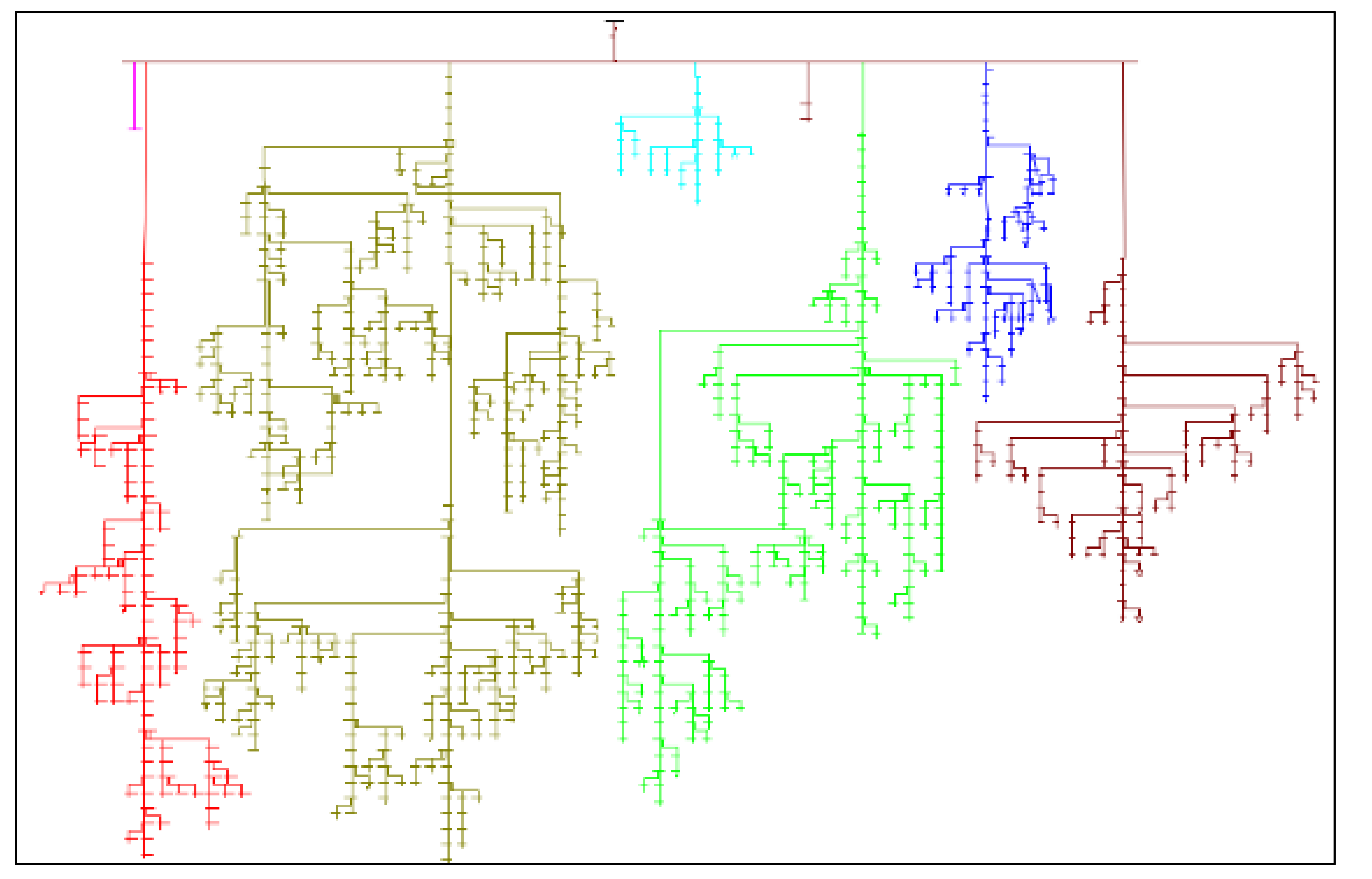
| Name | High Voltage (kV) | Low Voltage (kV) | Rated Power (MVA) |
|---|---|---|---|
| Secondary substation | 20 | 0.4 | 0.4 |
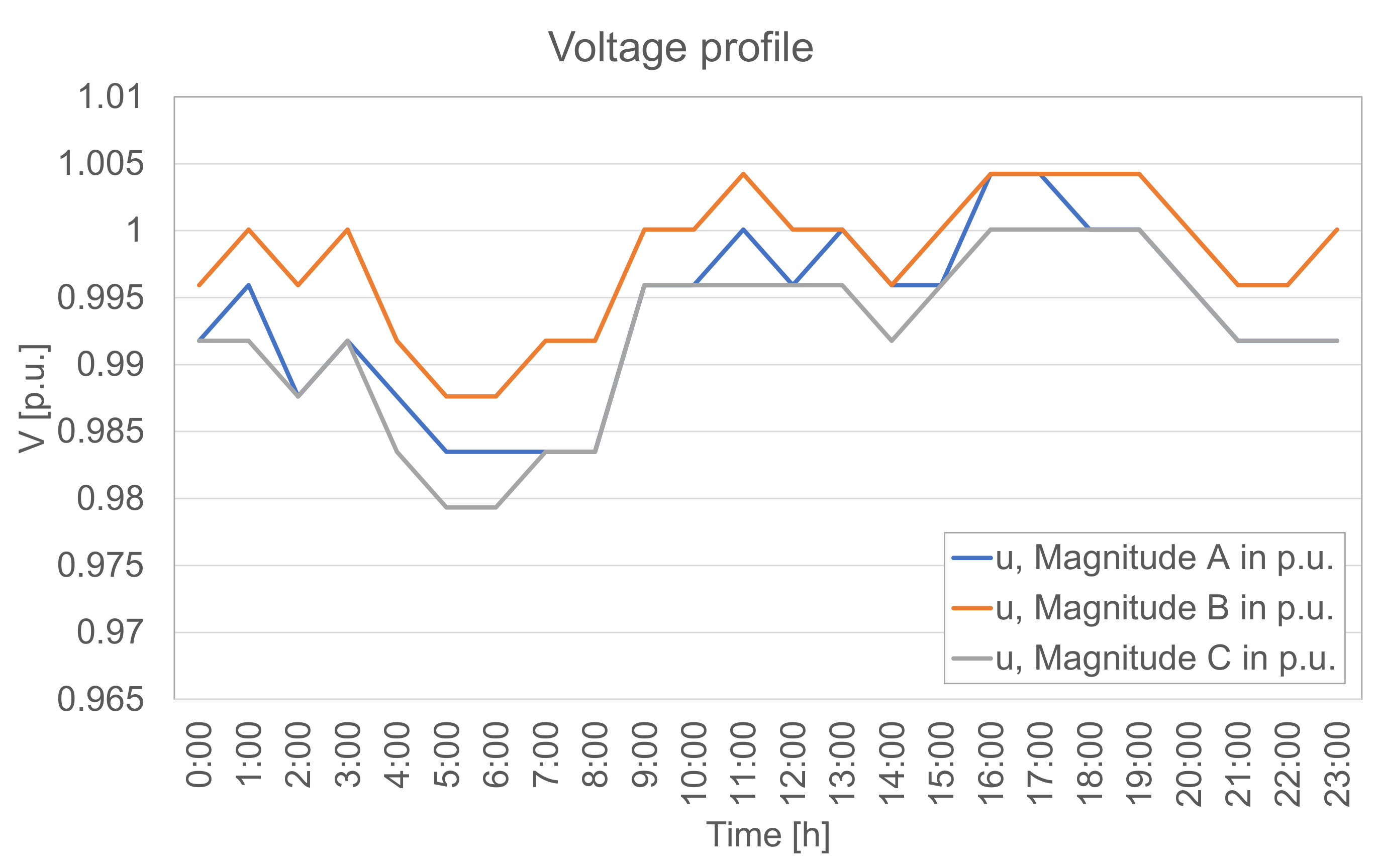
| Conductor Type | Voltage (kV) | Current (kA) | 3-Phase or 1-Phase | R (Ohm/km) | X (Ohm/km) | L (mH/km) |
|---|---|---|---|---|---|---|
| RV 2 × 25 AL | 0.4 | 0.074 | 1-Phase | 1.44 | 0.078 | 0.2482817 |
| RV 2 × 50 AL | 0.4 | 0.105 | 1-Phase | 0.77 | 0.0777 | 0.2473268 |
| RV 3 × 150 AL | 0.4 | 0.2 | 3-Phase | 0.249 | 0.072 | 0.2291831 |
| RV 3 × 25 AL | 0.4 | 0.074 | 3-Phase | 1.44 | 0.078 | 0.2482817 |
| RV 3 × 50 AL | 0.4 | 0.105 | 3-Phase | 0.77 | 0.0777 | 0.2473268 |
| RV 4 × 50 AL | 0.4 | 0.105 | 3-Phase | 0.77 | 0.0777 | 0.2473268 |
| RV 4 × 95 AL | 0.4 | 0.155 | 3-Phase | 0.39 | 0.0733 | 0.2333211 |
| RZ 3 × 16 CU | 0.4 | 0.075 | 1-Phase | 1.45 | 0.0813 | 0.2587859 |
| RZ 3 × 6 CU | 0.4 | 0.053 | 3-Phase | 3.95 | 0.0901 | 0.2867972 |
| RZ 4 × 10AL | 0.4 | 0.054 | 3-Phase | 3.61 | 0.086 | 0.2737465 |
| RZ 4 × 16 AL | 0.4 | 0.058 | 3-Phase | 2.27 | 0.0813 | 0.2587859 |
| RZ 4 × 25 AL | 0.4 | 0.074 | 3-Phase | 1.44 | 0.078 | 0.2482817 |
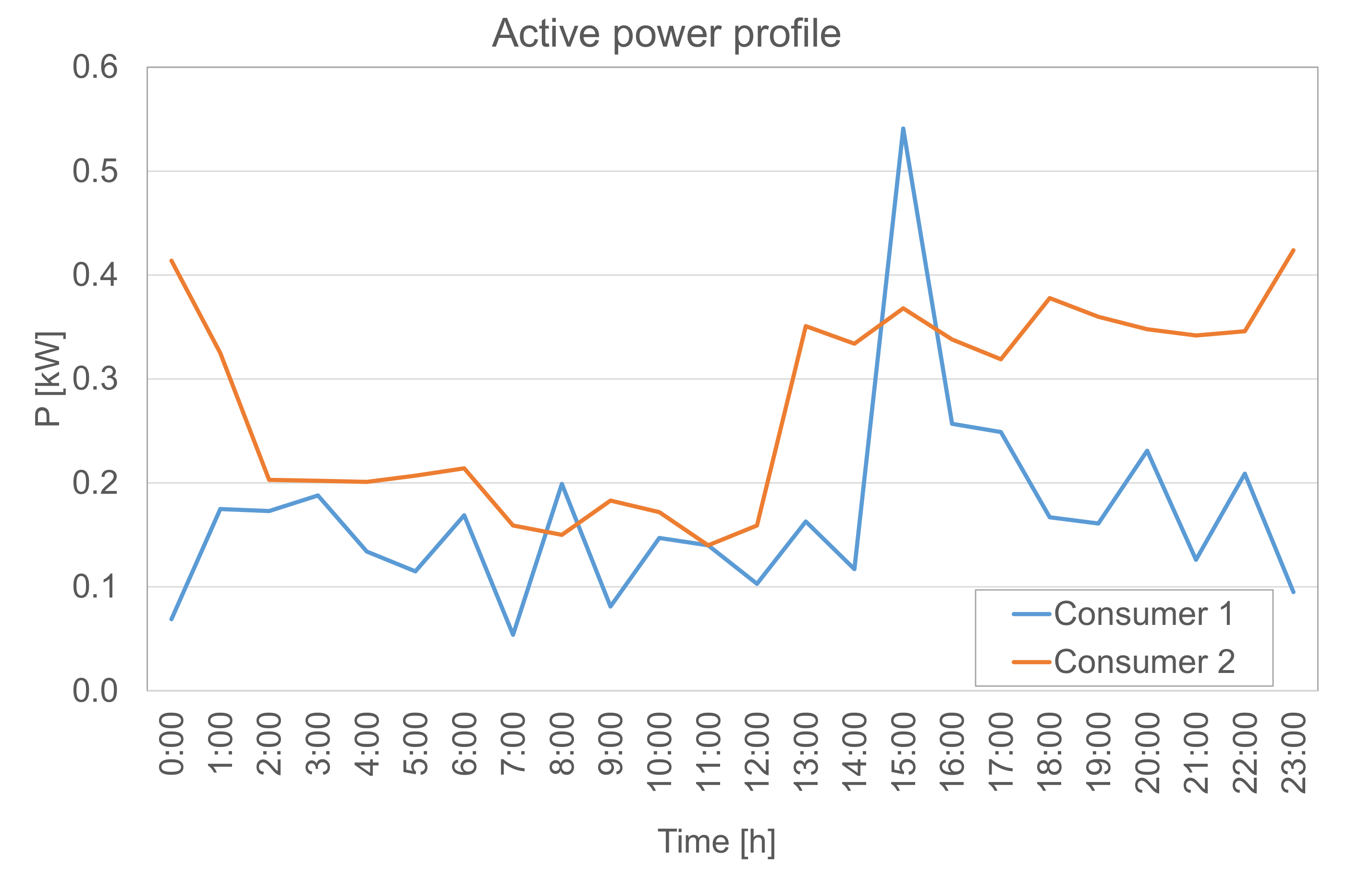
| Generator | 3-Phase or 1-Phase | Rated Power (kWp) |
|---|---|---|
| PV_gen_1 | 3-Phase | 40 |
| PV_gen_2 | 3-Phase | 40 |
| PV_gen_3 | 3-Phase | 40 |
| PV_pros_1 | 1-Phase | 3.3 |
| PV_pros_2 | 1-Phase | 3.3 |
| PV_pros_3 | 1-Phase | 3.3 |
| PV_pros_4 | 1-Phase | 3.3 |
Appendix A.2. Northern Europe Urban-Residential Grid

| Name | High Voltage (kV) | Low Voltage (kV) | Rated Power (MVA) |
|---|---|---|---|
| MV/LV Transformer | 10 | 0.4 | 0.8 |
| Conductor Type | Voltage (kV) | Current (kA) | 3-Phase or 1-Phase | R (Ohm/km) | X (Ohm/km) | L (mH/km) |
|---|---|---|---|---|---|---|
| AXQJ 4 × 240/146 | 0.6 | 0.7 | 3-Phase | 0.125 | 0.01 | 0.0318 |
| N1XV 4 × 95 | 0.6 | 0.308 | 3-Phase | 0.193 | 0.01 | 0.0318 |
| N1XV 5 × 16 | 0.6 | 0.098 | 3-Phase | 1.15 | 0.01 | 0.0318 |
| N1XV 5 × 10 | 0.6 | 0.06 | 3-Phase | 1.83 | 0.01 | 0.0318 |
- Figure A7 shows the proposed consumption of an EV in one day. As a simplification, it has been supposed that the same charging profile for the entire year of study and for all users.
- In Figure A8, the consumption of an outdoor swimming pool is shown. The operation of this demand point is supposed to cover seven months, from April to September.
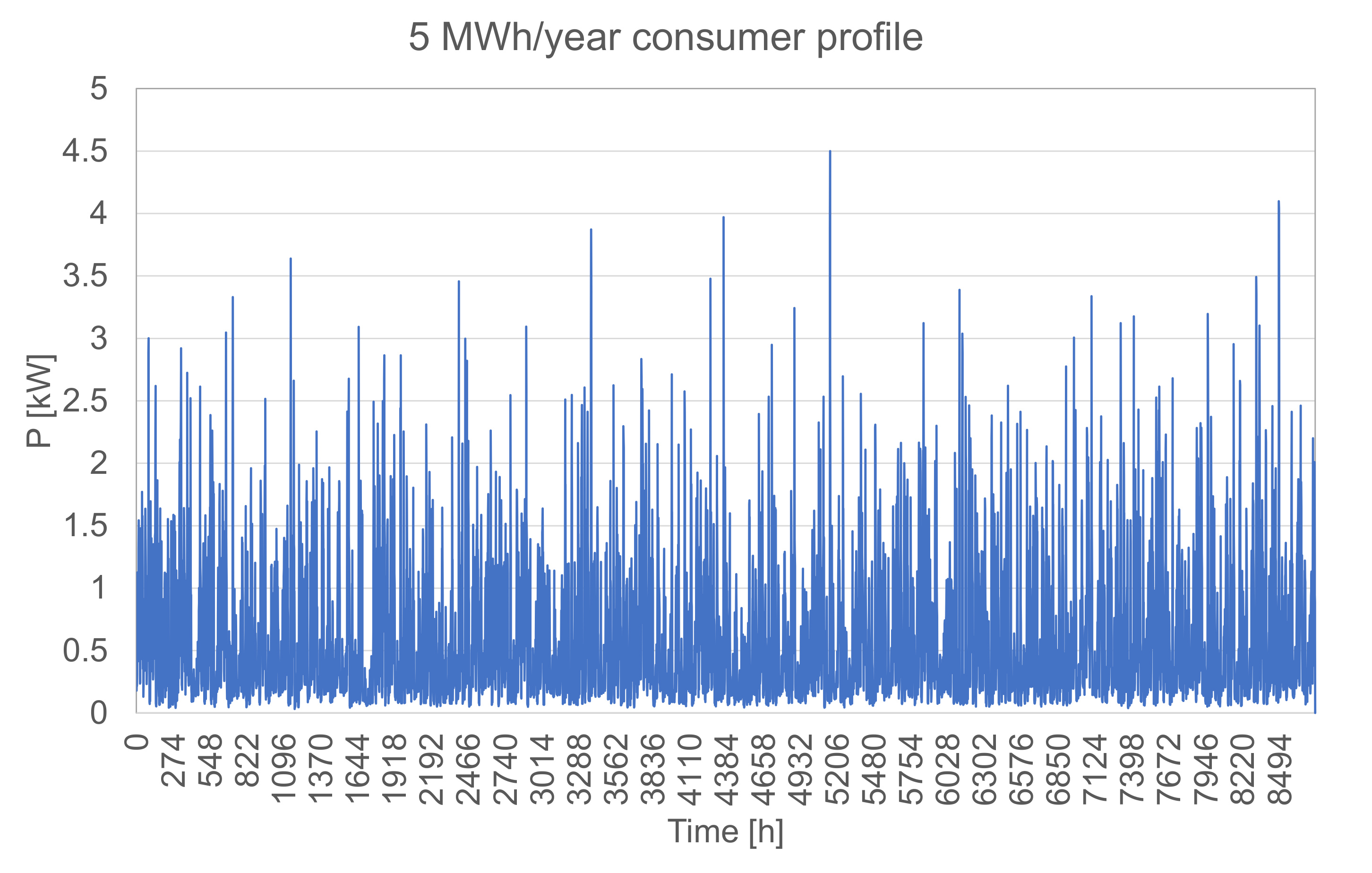
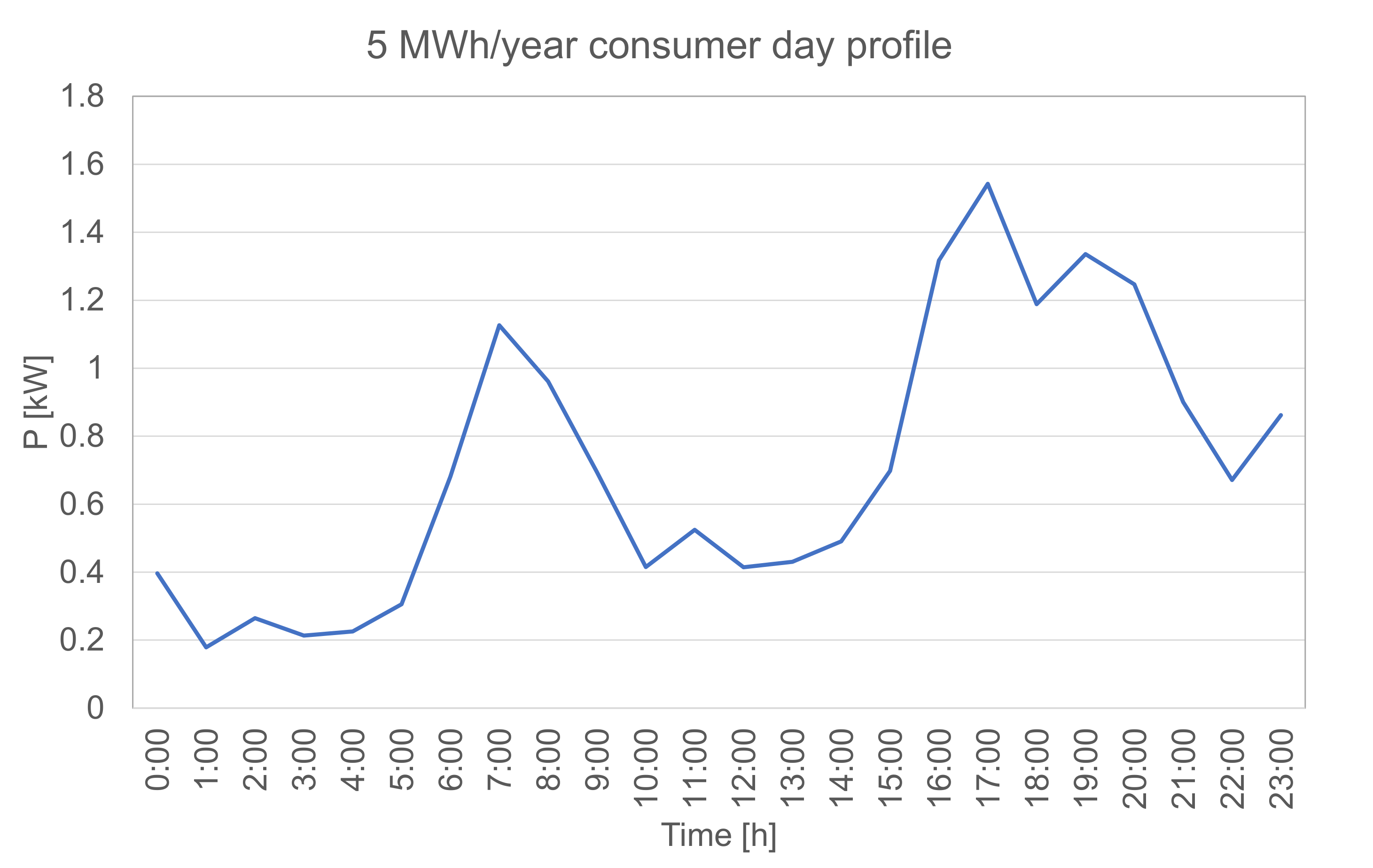
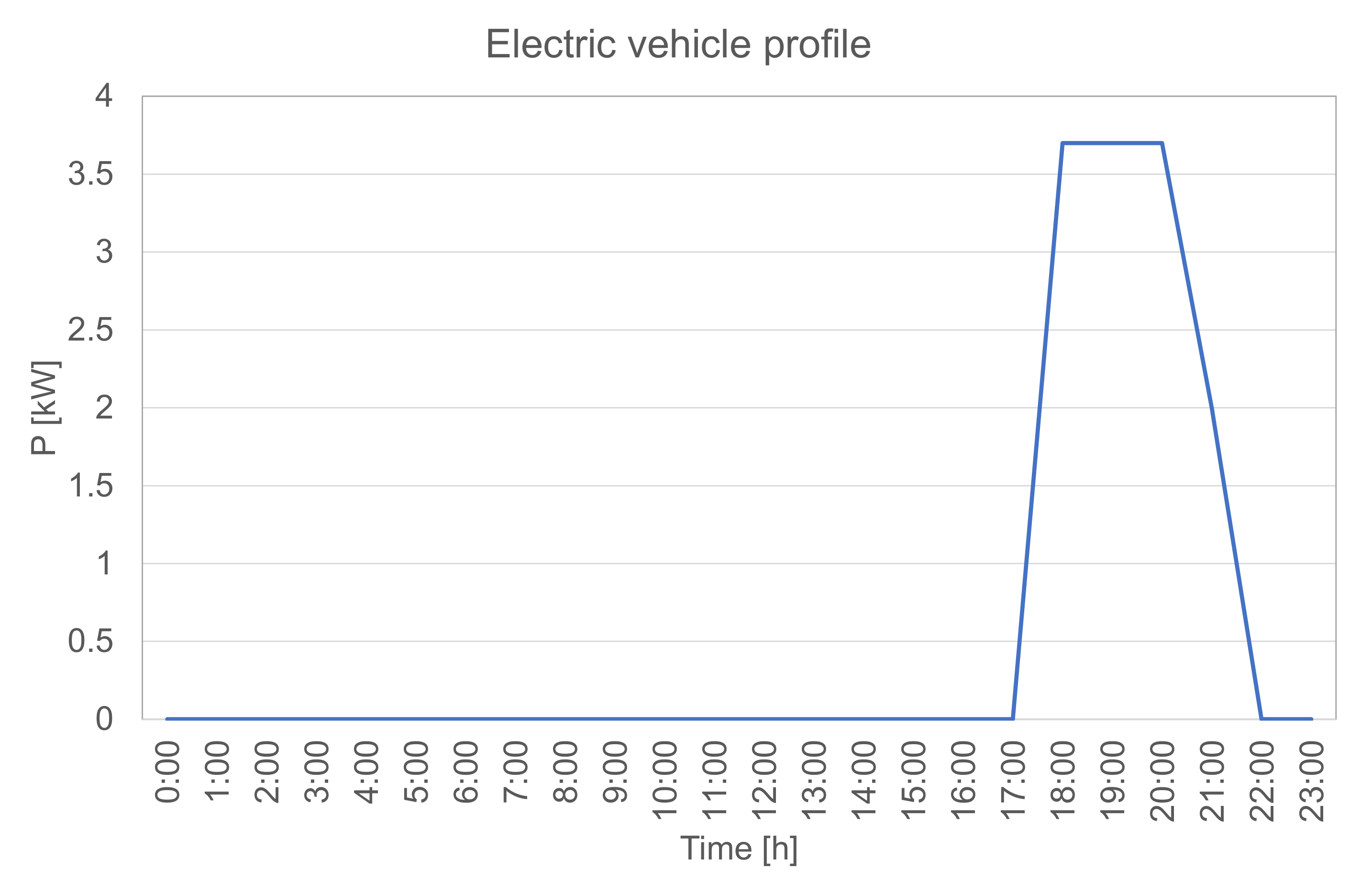
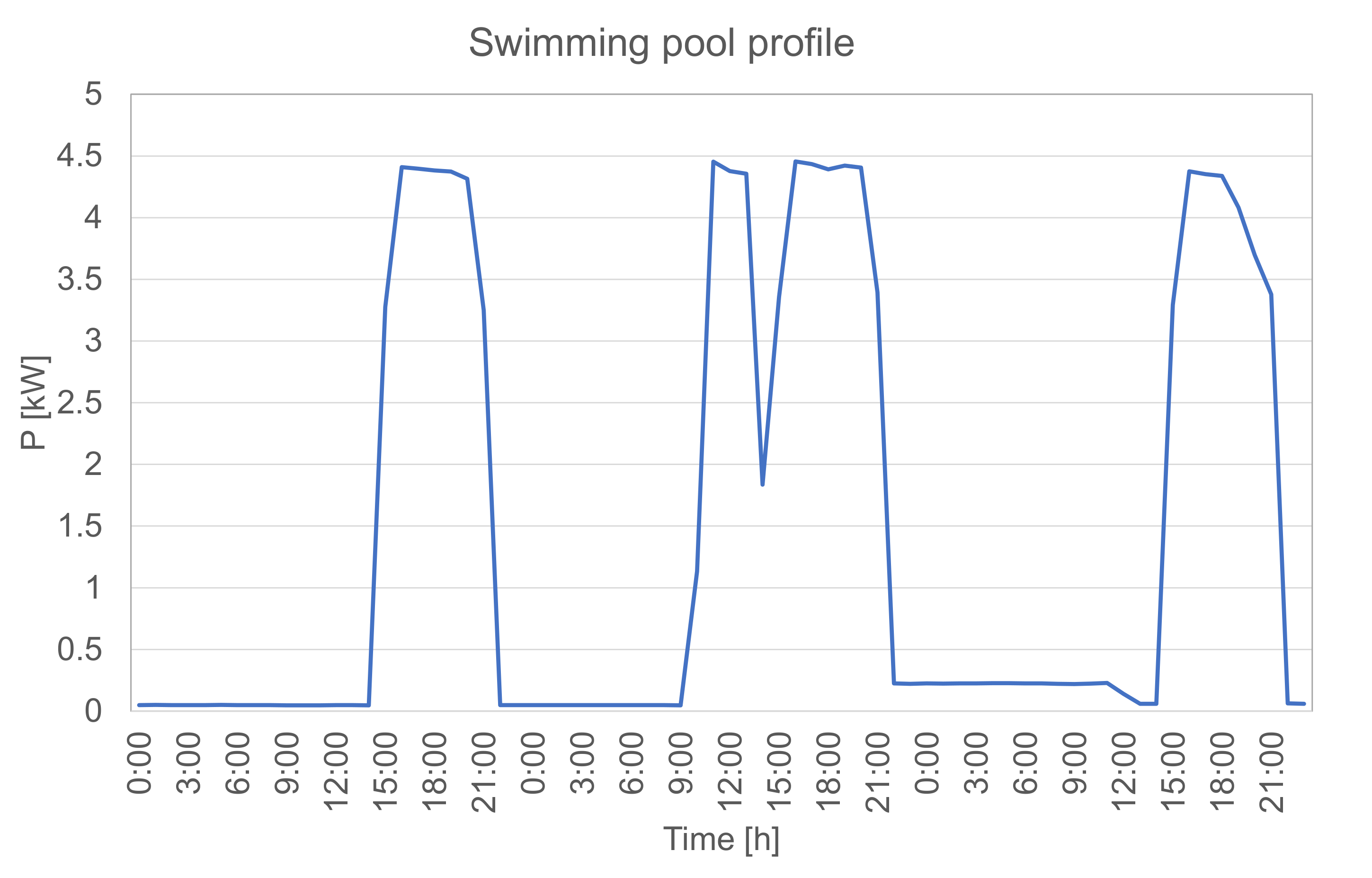
| Generator | 3-Phase or 1-Phase | Rated Power (kWp) |
|---|---|---|
| PV_ SR1 | 3-Phase | 31 |
| PV_ SR2 | 3-Phase | 31 |
| PV_SR3 | 3-Phase | 31 |
| Prosumer | 3-Phase or 1-Phase | Rated Power (kWp) |
|---|---|---|
| 1 | 3-Phase | 5 |
| 2 | 3-Phase | 6 |
| 3 | 3-Phase | 6 |
| 4 | 3-Phase | 6 |
| 5 | 3-Phase | 6 |
Appendix A.3. Central Europe Rural-Residential Grid

| Name | High Voltage (kV) | Low Voltage (kV) | Rated Power (MVA) |
|---|---|---|---|
| Secondary substation | 16.8 | 0.6 | 0.63 |
| Conductor Type | Voltage (kV) | Current (kA) | 3-Phase or 1-Phase | R (Ohm/km) | X (Ohm/km) | C (µF/km) |
|---|---|---|---|---|---|---|
| AXQJ 4 × 40/146 | 0.6 | 0.7 | 3-Phase | 0.125 | 0.01 | 0.0318 |
| GKN 3 × 95/95 CU | 0.6 | 0.316 | 3-Phase | 0.225 | 0.07 | 0.338 |
| GKN 3 × 25/25 CU | 0.6 | 0.151 | 3-Phase | 0.842 | 0.08 | 0.272 |
| GKN 3 × 50/50 CU | 0.6 | 0.215 | 3-Phase | 0.449 | 0.07 | 0.298 |
| GKN 3 × 150/150 CU | 0.6 | 0.4 | 3-Phase | 0.146 | 0.07 | 0.349 |
| Generator | 3-Phase or 1-Phase | Rated Power (kWp) |
|---|---|---|
| PV_1 | 3-Phase | 4 |
| PV_2 | 3-Phase | 27 |
| PV_3 | 3-Phase | 9 |
| PV_4 | 3-Phase | 14 |
| PV_5 | 3-Phase | 10 |
Appendix A.4. Southern Europe Urban Grid
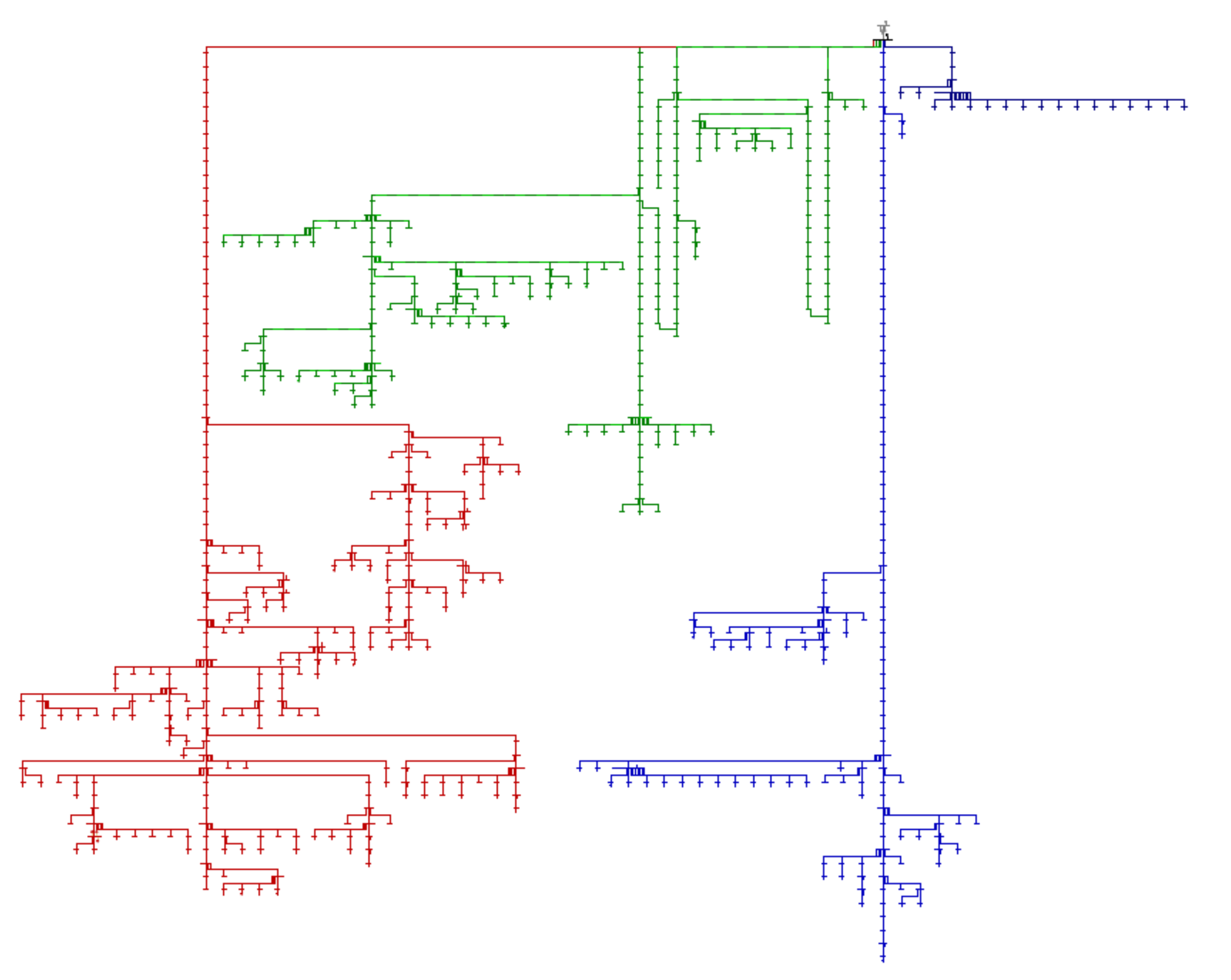
| Name | High Voltage (kV) | Low Voltage (kV) | Rated Power (MVA) |
|---|---|---|---|
| Secondary substation | 20 | 0.4 | 0.63 |
| Conductor Type | Voltage (kV) | Current (kA) | 3-phase or 1-phase | R (Ohm/km) | X (Ohm/km) | L (mH/km) |
|---|---|---|---|---|---|---|
| 3 × 150 AL + 50 CU XLPE | 0.6 | 0.29 | 3 | 0.206 | 0.12 | 0.3819 |
| 4 × 120 AL + 25 AL | 0.6 | 0.22 | 3 | 0.253 | 0.1 | 0.3183 |
| 4 × 35 + 16 AL | 0.6 | 0.058 | 3 | 0.0813 | 0.0813 | 0.2587 |
| Generator | Phase | Rated Power (kWp) |
|---|---|---|
| PV_319100015 | 3-phase | 14.3375 |
| PV_319100016 | 3-phase | 14.3375 |
Appendix B
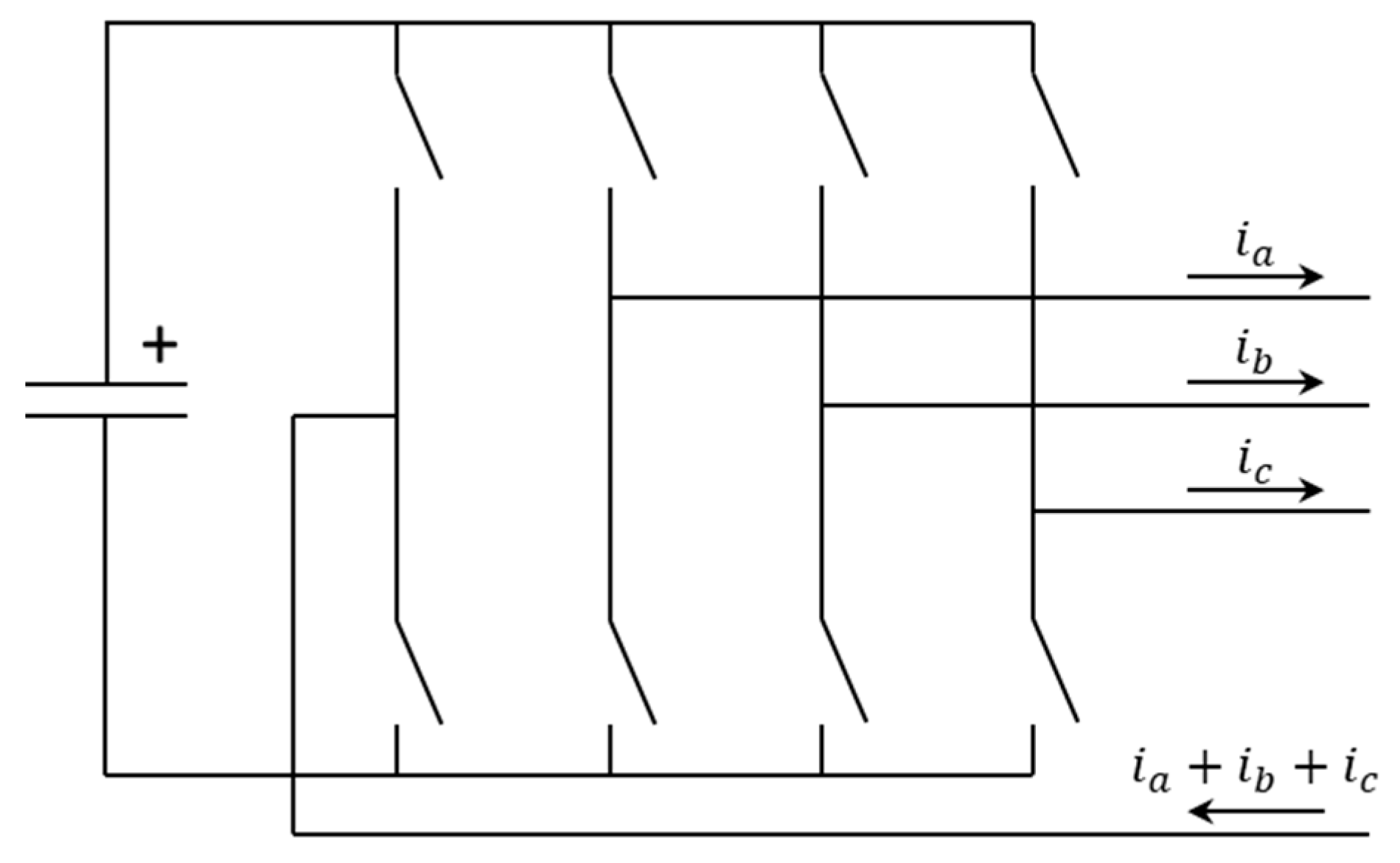
- Line current balancing. As above-mentioned, single phase loads produce different current flows in each phase of the network and also different voltage drops in each phase, affecting the power supply quality. This unbalance also increases the neutral current, requiring an oversizing of neutral cables and reducing energy efficiency and making failures more frequent. Figure A12 shows that the current injected by the D-STATCOM compensates for the unbalanced current demanded by consumers, so that current upstream is balanced and neutral current has been removed.
- Reactive compensation. Related to the previous point, reactive power compensation reduces power loses and voltage drops, improving the network operation.
- Voltage regulation. Similar to large STATCOMs used in transport network, a D-STATCOM can take advantage of the Ferranti effect to support voltage regulation in grid lines. In addition, this regulation can be carried out in a single-phase mode, applying an independent volt-var curve in each phase.
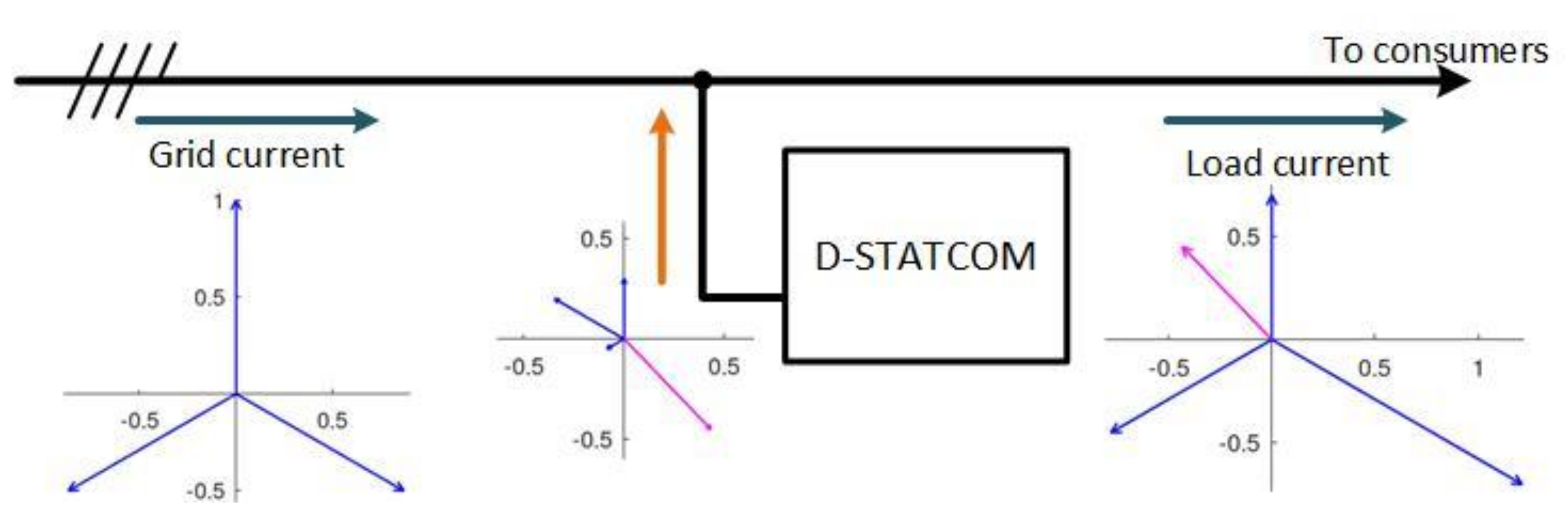
References
- The Intergovernmental Panel on Climate Change (IPCC). In Global Warming of 1.5 °C; IPCC: Geneva, Switzerland, 2018.
- Batel, S. Research on the social acceptance of renewable energy technologies: Past, present and future. Energy Res. Social Sci. 2020, 68, 101544. [Google Scholar] [CrossRef]
- The European Parliament and the Council of the European Union. Directive 2009/28/EC of 23 April 2009; European Parliament: Brussels, Belgium, 2009. [Google Scholar]
- European Commission. Available online: https://ec.europa.eu/energy/topics/energy-strategy/clean-energy-all-europeans_en (accessed on 15 October 2020).
- Verzijlbergh, R.; Vries, L.D.; Dijkema, G.; Herder, P. Institutional challenges caused by the integration of renewable energy sources in the European electricity sector. Renew. Sustain. Energy Rev. 2017, 75, 660–667. [Google Scholar] [CrossRef] [Green Version]
- Tech, V. Distributed Generation Educational Module. Available online: https://www.dg.history.vt.edu/ch1/introduction.html (accessed on 14 October 2020).
- European Commission. Study on the Effective Integration of Distributed; European Commission: Brussels, Belgium, 2015. [Google Scholar]
- Kharrazi, A.; Sreeram, V.; Mishra, Y. Assessment techniques of the impact of grid-tied rooftop photovoltaic generation on the power quality of low voltage distribution network—A review. Renew. Sustain. Energy Rev. 2020, 120, 109643. [Google Scholar] [CrossRef]
- Gandhi, O.; Zhang, W.; Rodríguez-Gallegos, C.D.; Srinivasan, D.; Reindl, T. Continuous optimization of reactive power from PV and EV in distribution system. In Proceedings of the 2016 IEEE Innovative Smart Grid Technologies—Asia (ISGT-Asia), Melbourne, Australia, 28 November–1 December 2016. [Google Scholar]
- Aziz, T.; Ketjoy, N. PV Penetration Limits in Low Voltage Networks and Voltage Variations. IEEE Access 2017, 5, 16784–16792. [Google Scholar] [CrossRef]
- International Energy Agency (IEA). Impacts of Power Penetration from Photovoltaic Power Systems in Distribution Networks; IEA: Paris, France, 2002. [Google Scholar]
- Masoum, A.S.; Moses, P.S.; Masoum, M.A.; Abu-Siada, A. Impact of rooftop PV generation on distribution transformer and voltage profile of residential and commercial networks. In Proceedings of the 2012 IEEE PES Innovative Smart Grid Technologies (ISGT), Washington, DC, USA, 16–20 January 2012; pp. 1–7. [Google Scholar]
- Zhang, C.; Ding, Y.; Nordentoft, N.C.; Pinson, P.; Østergaard, J. FLECH: A Danish market solution for DSO congestion. J. Mod. Power Syst. Clean Energy 2014, 2, 126–133. [Google Scholar] [CrossRef] [Green Version]
- Haque, A.N.M.M.; Nguyen, P.H.; Kling, W.L.; Bliek, F.W. Congestion management in smart distribution network. In Proceedings of the 2014 49th International Universities Power Engineering Conference (UPEC), Cluj-Napoca, Romania, 2–5 September 2014. [Google Scholar]
- Phuttapatimok, S.; Sangswang, A.; Seapan, M.; Chenvidhya, D.; Kirtikara, K. Evaluation of fault contribution in the presence of PV grid-connected systems. In Proceedings of the 33rd IEEE Photovoltaic Specialists Conference, San Diego, CA, USA, 11–16 May 2008; pp. 1–5. [Google Scholar]
- Rafi, F.H.M.; Hossain, M.J.; Rahman, M.S.; Taghizadeh, S. An overview of unbalance compensation techniques using power electronic converters for active distribution systems with renewable generation. Renew. Sustain. Energy Rev. 2020, 125, 109812. [Google Scholar] [CrossRef]
- Almeida, D.; Abeysinghe, A.; Ekanayake, J.B. Analysis of rooftop solar impacts on distribution networks. Ceylon J. Sci. 2019, 48, 103–112. [Google Scholar] [CrossRef] [Green Version]
- Schwanz, D.; Möller, F.; Rönnberg, S.K.; Meyer, J.; Bollen, M.H.J. Stochastic Assessment of Voltage Unbalance Due to Single-Phase-Connected Solar Power. IEEE Trans. Power Deliv. 2016, 32, 852–861. [Google Scholar] [CrossRef]
- Garrett, D.; Jeter, S. A photovoltaic voltage regulation impact investigation technique. I. Model development. IEEE Trans. Energy Convers. 1989, 4, 47–53. [Google Scholar] [CrossRef]
- Wang, L.; Yan, R.; Saha, T.K. Voltage regulation challenges with unbalanced PV integration in low voltage distribution systems and the corresponding solution. Appl. Energy 2019, 256, 113927. [Google Scholar] [CrossRef]
- Mateo, C.; Cossenta, R.; Gómez, T.; Prettico, G.; Frías, P.; Fulli, G.; Meletiou, A.; Postigo, F. Impact of solar PV self-consumption policies on distribution networks and regulatory implications. Sol. Energy 2018, 176, 62–72. [Google Scholar] [CrossRef]
- Sauhats, A.; Zemite, L.; Petrichenko, L.; Moshkin, I.; Jasevics, A. Estimating the Economic Impacts of Net Metering Schemes for Residential PV Systems with Profiling of Power Demand, Generation, and Market Prices. Energies 2018, 11, 3222. [Google Scholar] [CrossRef] [Green Version]
- Huang, S.; Wu, Q.; Liu, Z.; Nielsen, A.H. Review of congestion management methods for distribution networks with high penetration of distributed energy resources. In Proceedings of the IEEE PES Innovative Smart Grid Technologies, Europe, Istanbul, Turkey, 12–15 October 2014; pp. 1–6. [Google Scholar]
- Marini, A.; Ghazizadeh, M.S.; Mortazavi, S.S.; Piegari, L. A harmonic power market framework for compensation management of DER based active power filters in microgrids. Electr. Power Energy Syst. 2019, 113, 916–931. [Google Scholar] [CrossRef]
- Torres, I.C.; Negreiros, G.F.; Tiba, C. Theoretical and Experimental Study to Determine Voltage Violation, Reverse Electric Current and Losses in Prosumers Connected to Low-Voltage Power Grid. Energies 2019, 12, 4568. [Google Scholar] [CrossRef] [Green Version]
- Hong, B.; Li, Q.; Miao, W.; Yan, H.; Liu, J. Energy Storage Application in Improving Distribution Network’s Solar Photovoltaic (PV) Adoption Capability. Energy Procedia 2018, 145, 472–477. [Google Scholar] [CrossRef]
- Bremdal, B.A.; Sæle, H.; Mathisen, G.; Degefa, M.Z. Flexibility offered to the distribution grid from households with a photovoltaic panel on their roof: Results and experiences from several pilots in a Norwegian research project. In Proceedings of the 2018 IEEE International Energy Conference (ENERGYCON), Limassol, Cyprus, 3–7 June 2018; pp. 1–6. [Google Scholar]
- Wind EUROPE. Repowering and Lifetime Extension: Making the Most of Europe’s Wind Energy Resource; Wind EUROPE: Brussels, Belgium, 2017. [Google Scholar]
- Ren, B.; Zhang, M.; An, S.; Sun, X. Local Control Strategy of PV Inverters for Overvoltage Prevention in Low Voltage Feeder. In Proceedings of the 2016 IEEE 11th Conference on Industrial Electronics and Applications, Hefei, China, 5–7 June 2016; pp. 2071–2075. [Google Scholar]
- Fernández, G.; Galan, N.; Marquina, D.; Martínez, D.; Sanchez, A.; López, P.; Bludszuweit, H.; Rueda, J. Photovoltaic Generation Impact Analysis in Low Voltage Distribution Grids. Energies 2020, 13, 4347. [Google Scholar] [CrossRef]
- Jeong, Y.-C.; Lee, E.-B.; Alleman, D. Reducing Voltage Volatility with Step Voltage Regulators: A Life-Cycle Cost Analysis of Korean Solar Photovoltaic Distributed Generation. Energies 2019, 12, 652. [Google Scholar] [CrossRef] [Green Version]
- Kahingala, T.D.; Perera, S.; Agalgaonkar, A.P.; Jayatunga, U. STATCOM Based Network Voltage Unbalance Mitigation for Sub-Transmission Networks. In Proceedings of the IEEE Innovative Smart Grid Technologies—Asia (ISGT Asia), Chengdu, China, 21–24 May 2019; pp. 2624–2628. [Google Scholar]
- Kahingala, T.D.; Perera, S.; Jayatunga, U.; Agalgaonkar, A.P. Network-Wide Influence of a STATCOM Configured for Voltage Unbalance Mitigation. IEEE Trans. Power Deliv. 2020, 35, 1602–1605. [Google Scholar] [CrossRef]
- Rodríguez, A.; Bueno, E.J.; Mayor, Á.; Rodríguez, F.J.; García-Cerrada, A. Voltage Support Provided by STATCOM in Unbalanced Power Systems. Energies 2014, 7, 1003–1026. [Google Scholar] [CrossRef] [Green Version]
- Afzal, M.M.; Khan, M.A.; Hassan, M.A.S.; Wadood, A.; Uddin, W.; Hussain, S.; Rhee, S.B. A Comparative Study of Supercapacitor-Based STATCOM in a Grid-Connected Photovoltaic System for Regulating Power Quality Issues. Sustainability 2020, 12, 6781. [Google Scholar] [CrossRef]
- Kotsampopoulos, P.; Georgilakis, P.; Lagos, D.T.; Kleftakis, V.; Hatziargyriou, N. FACTS Providing Grid Services: Applications and Testing. Energies 2019, 12, 2554. [Google Scholar] [CrossRef] [Green Version]
- Yuvaraj, T.; Devabalaji, K.R.; Ravi, K. Optimal Placement and Sizing of DSTATCOM Using Harmony Search Algorithm. Energy Procedia 2015, 79, 759–765. [Google Scholar] [CrossRef] [Green Version]
- Sirjani, R. Optimal placement and sizing of distribution static compensator (D-STATCOM) in electric distribution networks: A review. Renew. Sustain. Energy Rev. 2017, 77, 688–694. [Google Scholar] [CrossRef]
- Hussain, S.M. An analytical approach for optimal location of DSTATCOM in radial distribution system. In Proceedings of the 2013 International Conference on Energy Efficient Technologies for Sustainability, ICEETS 2013, Nagercoil, India, 10–12 April 2013. [Google Scholar]
- Tuzikova, V.; Tlusty, J.; Muller, Z. A Novel Power Losses Reduction Method Based on a Particle Swarm Optimization Algorithm Using STATCOM. Energies 2018, 11, 2851. [Google Scholar] [CrossRef] [Green Version]
- Sirjani, R. Optimal Placement and Sizing of PV-STATCOM in Power Systems Using Empirical Data and Adaptive Particle Swarm Optimization. Sustainability 2018, 10, 727. [Google Scholar] [CrossRef] [Green Version]
- Shirmohammadi, D.; Wollenberg, B.; Vojdani, A.; Sandrin, P.; Pereira, M.; Rahimi, F.; Schneider, T.; Stott, B. Transmission dispatch and congestion management in the emerging energy market structures. IEEE Trans. Power Syst. 1998, 13, 1466–1474. [Google Scholar] [CrossRef]
- Oloulade, A.; Imano, A.M.; Viannou, A.; Tamadaho, H. Optimization of the number, size and placement of D-STATCOM in radial distribution network using Ant Colony Algorithm. Am. J. Eng. Res. Rev. 2018, 1, 12. [Google Scholar]
- Gupta, A.R.; Kumar, A. Impact of various load models on D-STATCOM allocation in DNO operated distribution network . Procedia Comput. Sci. 2018, 125, 862–870. [Google Scholar]
- Gupta, A.R.; Kumar, A. Impact of DG and D-STATCOM Placement on Improving the Reactive Loading Capability of Mesh Distribution System. Procedia Technol. 2016, 25, 676–683. [Google Scholar] [CrossRef] [Green Version]
- Gupta, A.R.; Kumar, A. Energy Saving Using D-STATCOM Placement in Radial Distribution System under Reconfigured Network. Energy Procedia 2016, 90, 124–136. [Google Scholar] [CrossRef]
- Gupta, A.R.; Kumar, A. Optimal placement of D-STATCOM using sensitivity approaches in mesh distribution system with time variant load models under load growth. Ain Shams Eng. J. 2018, 9, 783–799. [Google Scholar] [CrossRef] [Green Version]
- Gupta, A.R.; Kumar, A. Impact of D-STATCOM Placement on Improving the Reactive Loading Capability of Unbalanced Radial Distribution System. Procedia Technol. 2016, 25, 759–766. [Google Scholar] [CrossRef] [Green Version]
- Rezaeian-Marjani, S.; Galvani, S.; Talavat, V.; Farhadi-Kangarlu, M. Optimal allocation of D-STATCOM in distribution networks including correlated renewable energy sources. Int. J. Electr. Power Energy Syst. 2020, 122, 106178. [Google Scholar] [CrossRef]
- Mohamed, M.A.E.S.; Mohammed, A.A.E.; Abd Elhamed, A.M.; Hessean, M.E. Optimal Allocation of Photovoltaic Based and DSTATCOM in a Distribution Network under Multi Load Levels. Eur. J. Eng. Res. Sci. 2019, 4, 114–119. [Google Scholar] [CrossRef]
- Thangaraj, Y.; Kuppan, R. Multi-objective simultaneous placement of DG and DSTATCOM using novel lightning search algorithm. J. Appl. Res. Technol. 2017, 15, 477–491. [Google Scholar] [CrossRef]
- Singh, B.; Yadav, M.K. GA for enhancement of system performance by DG incorporated with D-STATCOM in distribution power networks. J. Electr. Syst. Inf. Technol. 2018, 5, 388–426. [Google Scholar] [CrossRef]
- Castiblanco-Pérez, C.M.; Toro-Rodríguez, D.E.; Montoya, O.D.; Giral-Ramírez, D.A. Optimal Placement and Sizing of D-STATCOM in Radial and Meshed Distribution Networks Using a Discrete-Continuous Version of the Genetic Algorithm. Electronics 2021, 10, 1452. [Google Scholar] [CrossRef]
- Ruiz, J.L. Metaheurísticas para el Análisis de Datos Masivos en el Ámbito del Transporte por Carretera; Universidad Politécnica de Madrid: Madrid, Spain, 2017. [Google Scholar]
- DIgSILENT | POWER SYSTEM SOLUTIONS. Available online: https://www.digsilent.de/en/ (accessed on 21 April 2021).
- CENELEC. EN 50160—Voltage Characteristics of Electricity Supplied by Public Electricity Networks; CENELEC: Brussels, Belgium, 2011. [Google Scholar]
- Block, I. About the Method of Unification of the Program-Algorithmic Model of Multi-Agent Optimization Methods Using the Example of the Particle Swarm Method. Available online: https://www.sciencedirect.com/science/article/abs/pii/S0169743915002117 (accessed on 15 April 2021).
- Ryan, M.J.; De Doncker, R.W.; Lorenz, R.D. Decoupled control of a four-leg inverter via a new 4/spl times/4 transformation matrix. IEEE Trans. Power Electron. 2001, 16, 694–701. [Google Scholar] [CrossRef] [Green Version]
- Ballestín, J. 4-Leg D-STATCOM for the Balancing of the Low-Voltage Distribution Grid; Semana Virtual 2020—CIGRE España; CIGRE España: Alcobendas, Spain, 2020. [Google Scholar]

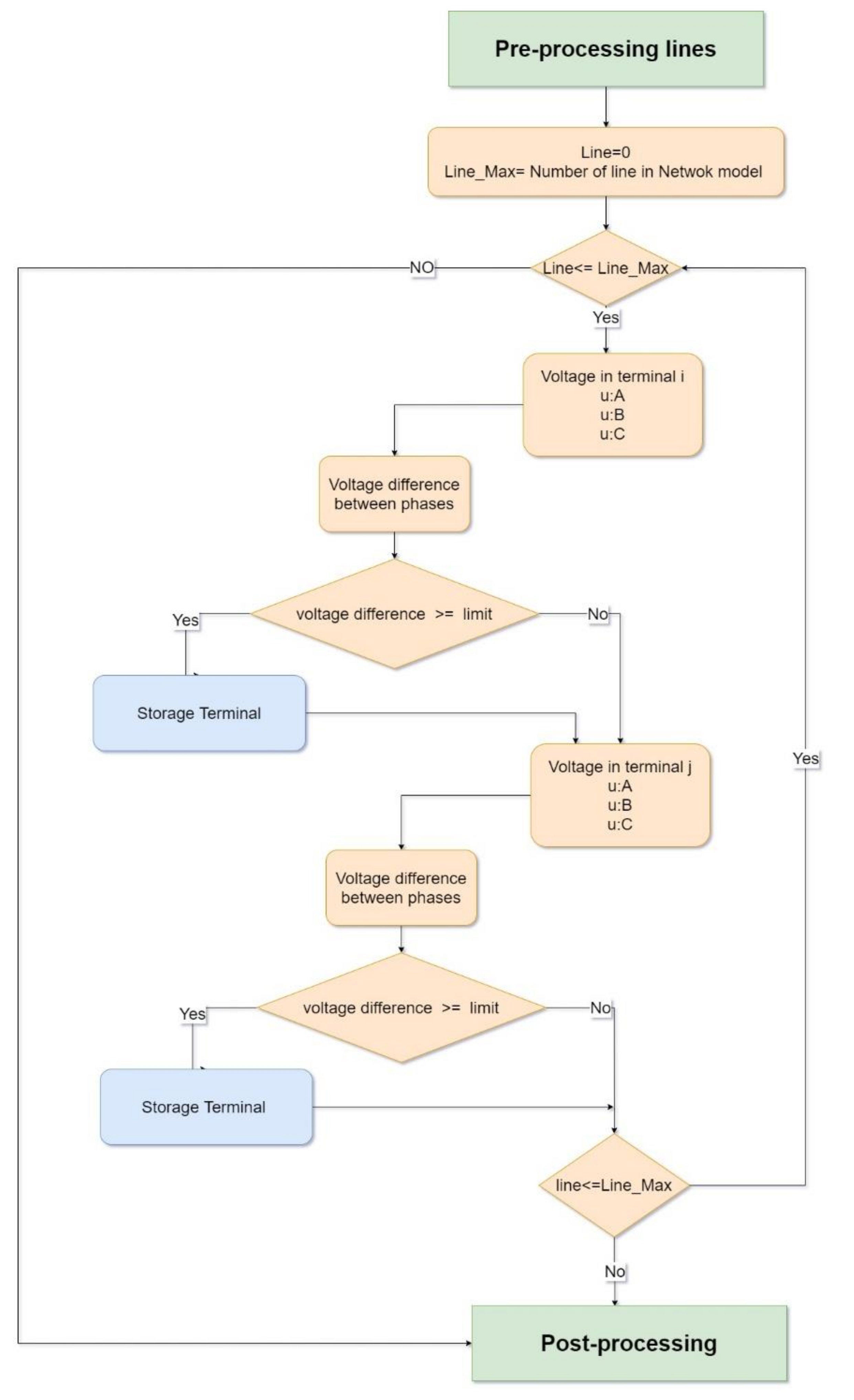
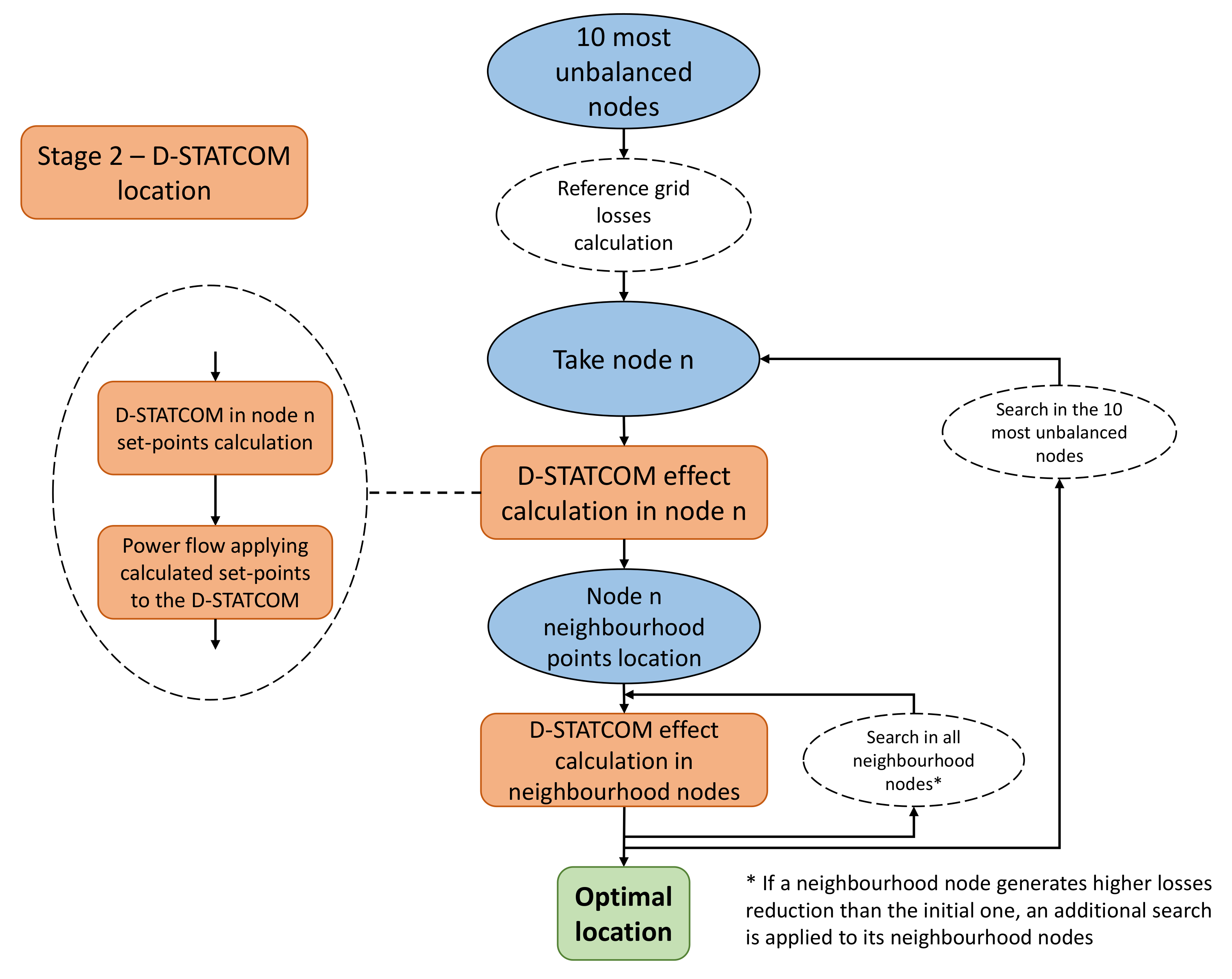

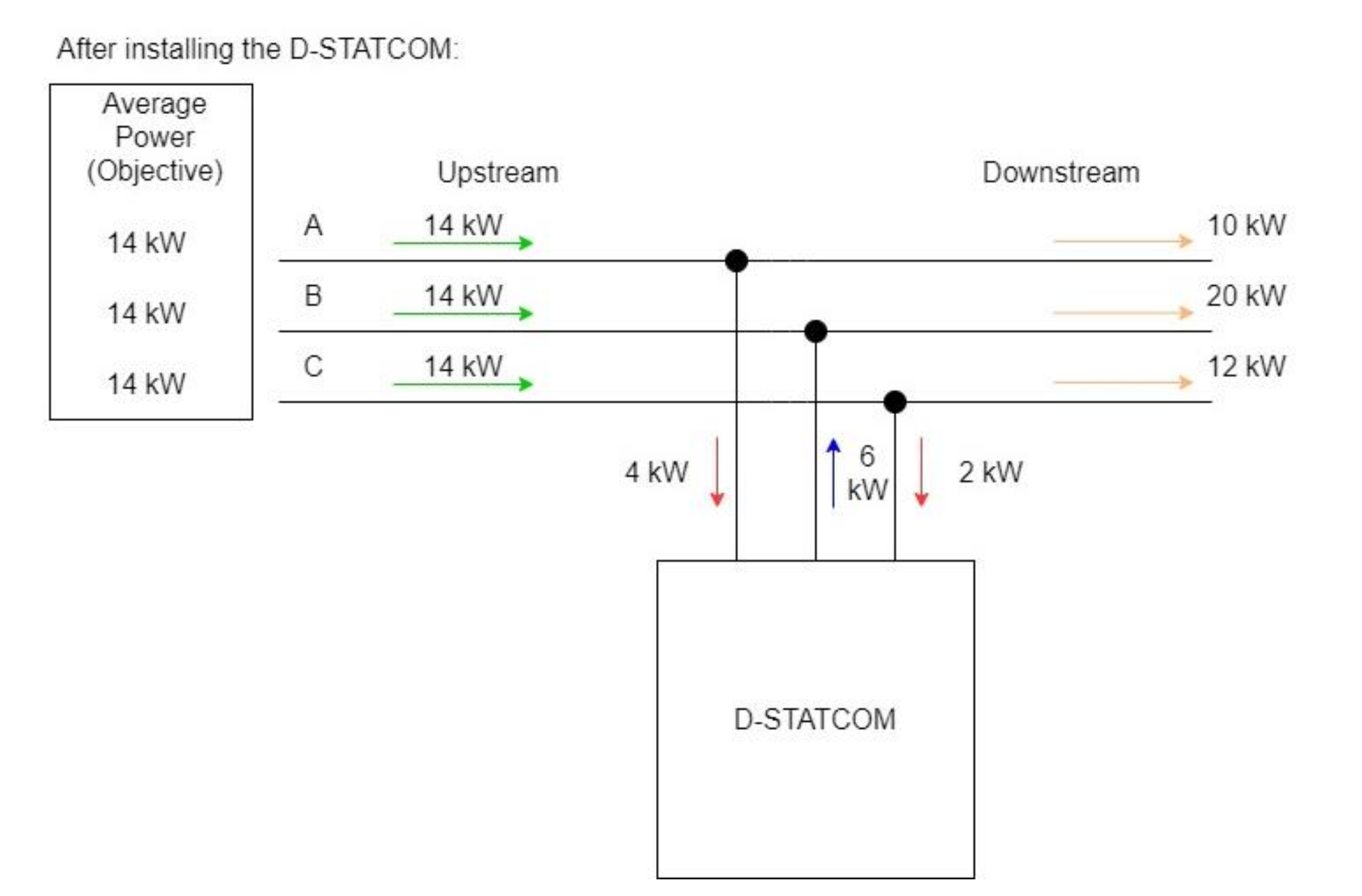
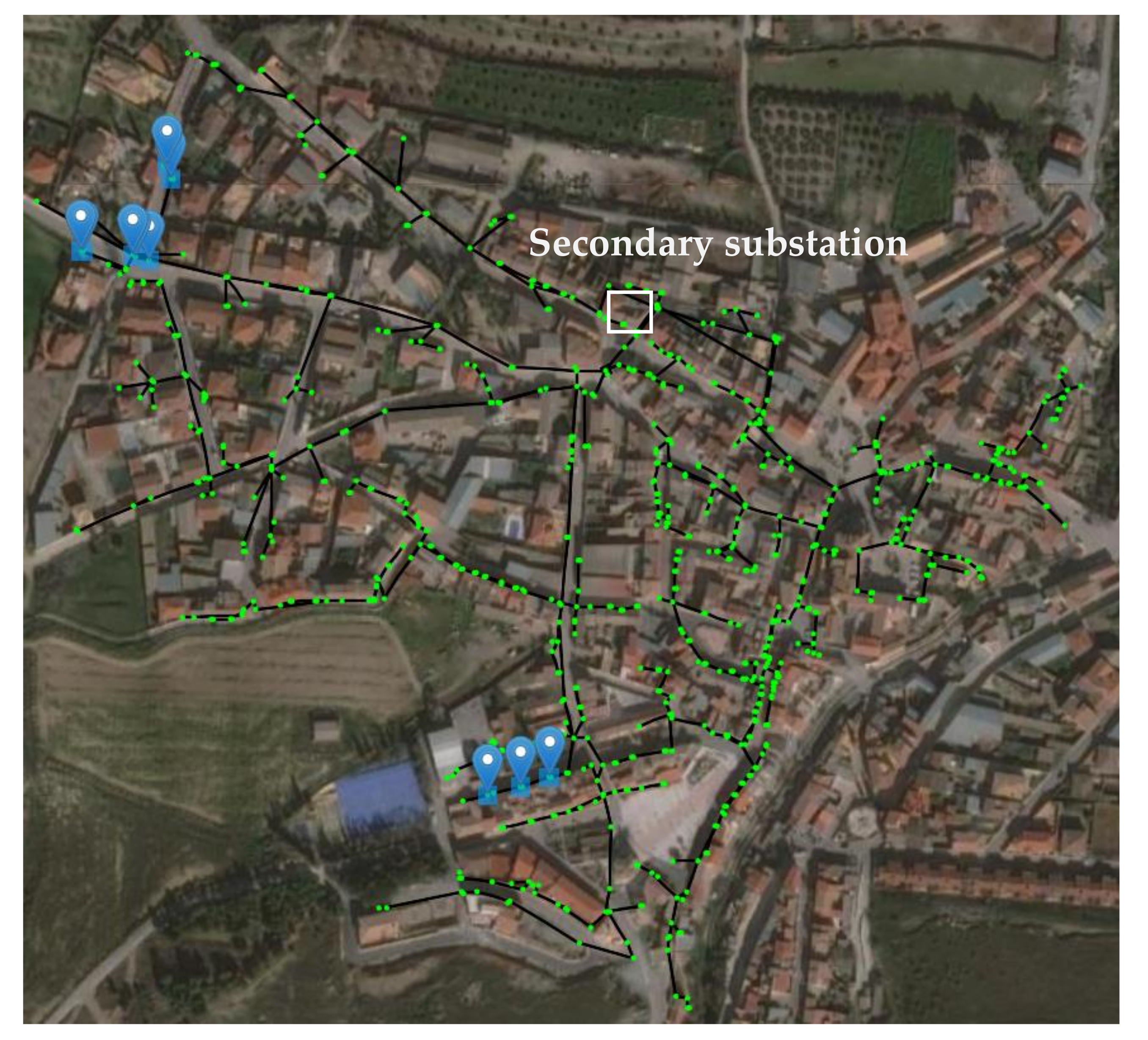
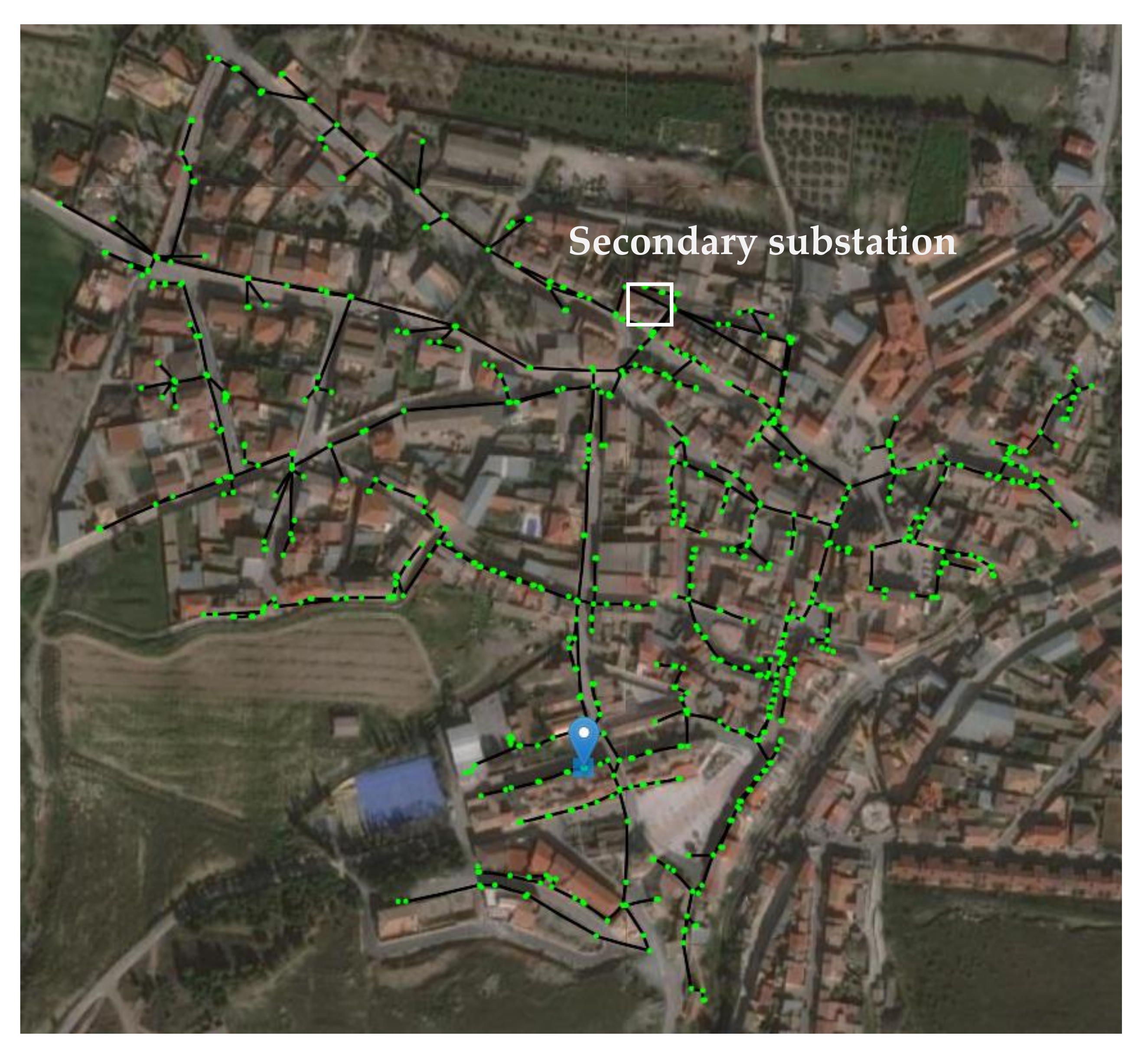
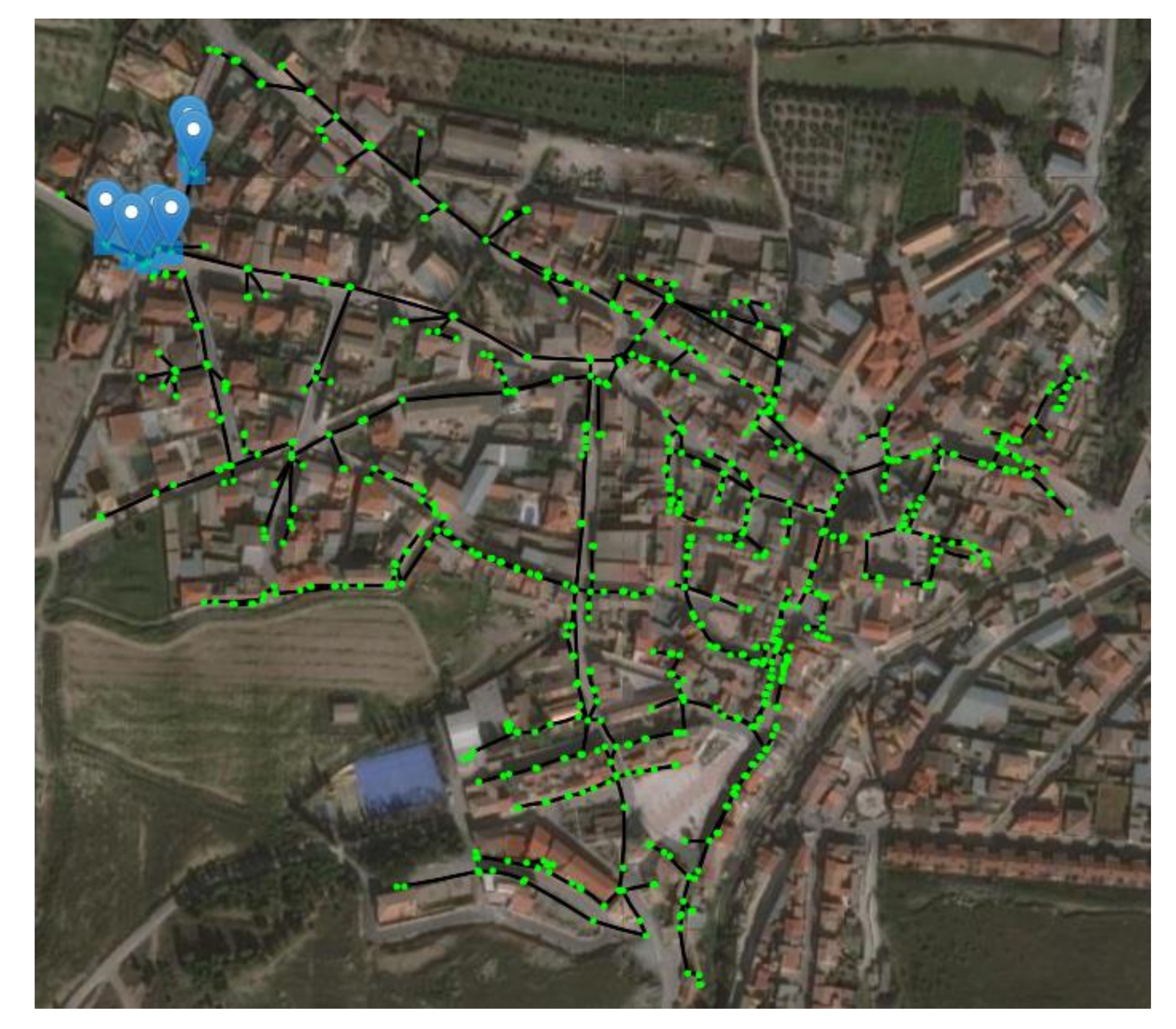
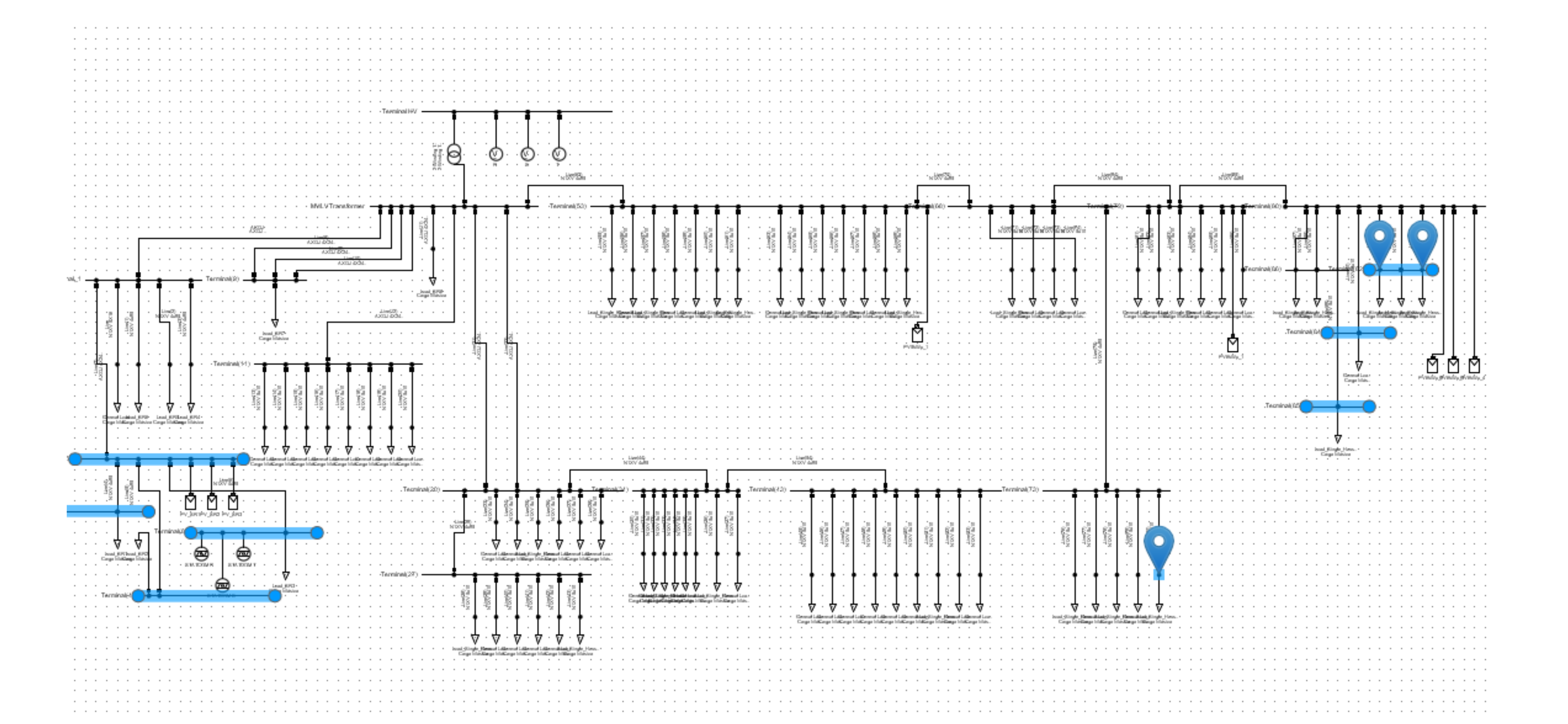
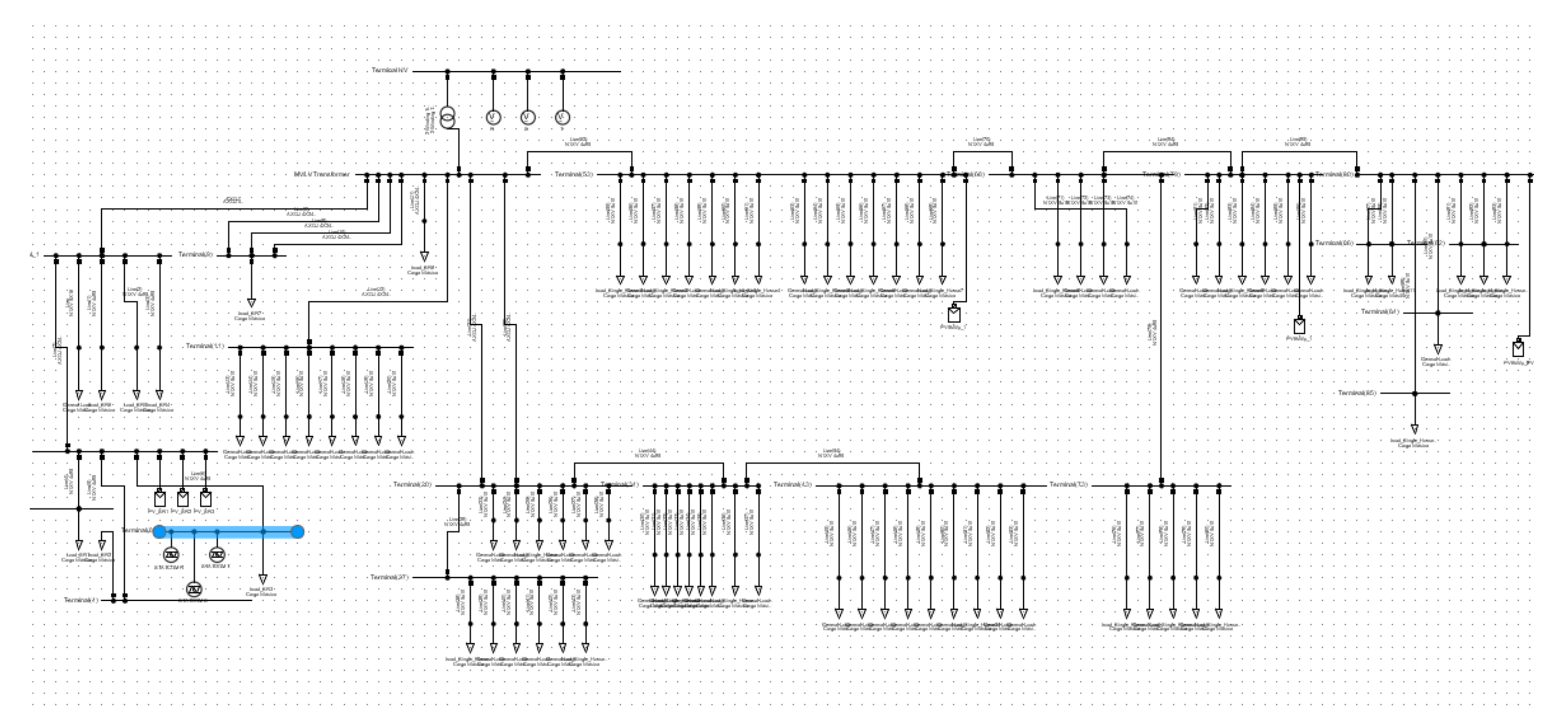
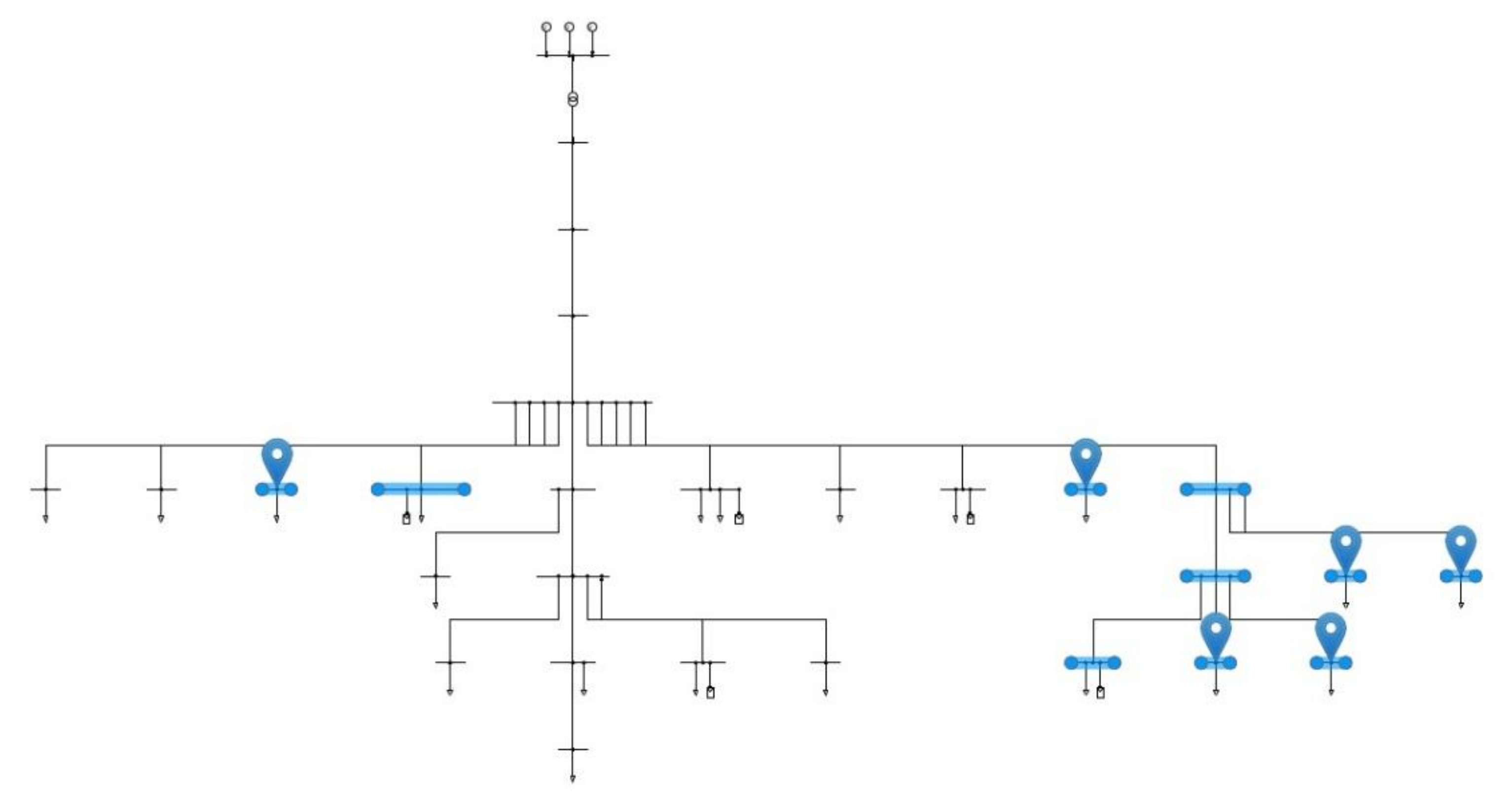
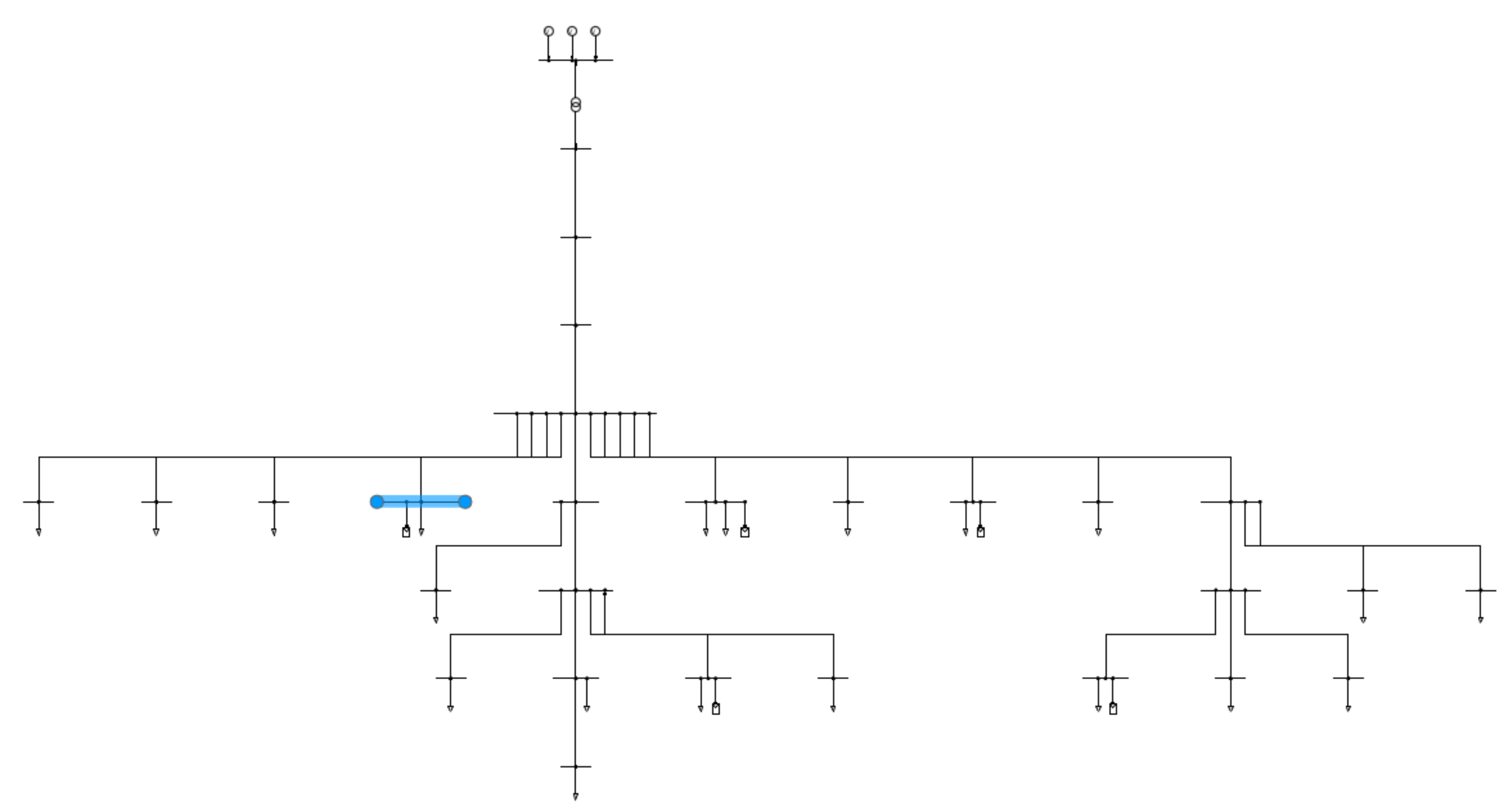
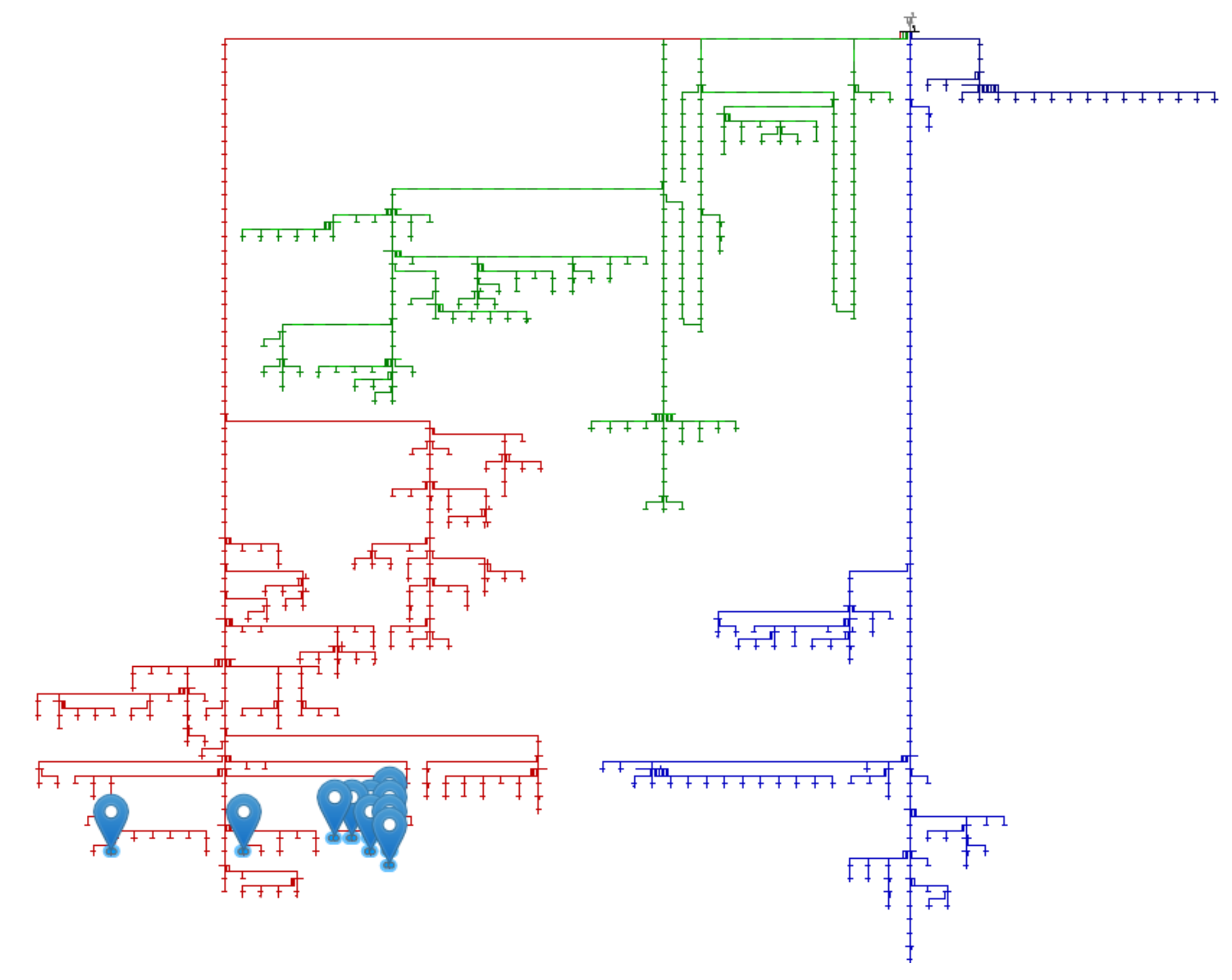
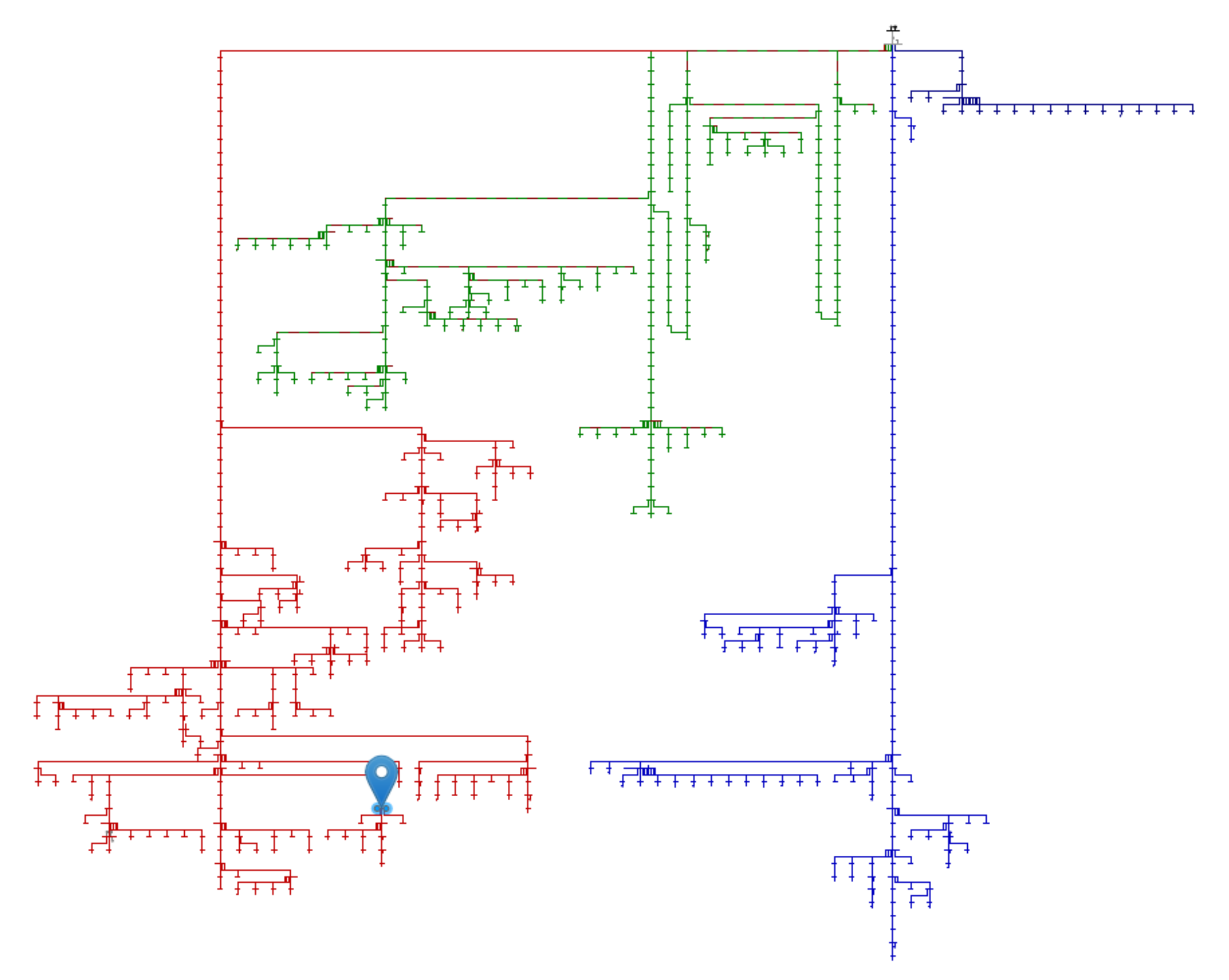
| Terminal | AB Avg (p.u.) | AB Max (p.u.) | AC Avg (p.u.) | AC Max (p.u.) | BC Avg (p.u.) | BC Max (p.u.) | Occurrences |
|---|---|---|---|---|---|---|---|
| T_L04_181 | 0.026 | 0.089 | 0.015 | 0.076 | 0.011 | 0.026 | 2675 |
| T_L04_179 | 0.026 | 0.088 | 0.014 | 0.075 | 0.012 | 0.026 | 2531 |
| T_L04_177 | 0.025 | 0.086 | 0.014 | 0.073 | 0.012 | 0.026 | 2299 |
| T_L04_249 | 0.024 | 0.046 | 0.011 | 0.043 | 0.018 | 0.052 | 2098 |
| T_L04_248 | 0.024 | 0.046 | 0.011 | 0.044 | 0.018 | 0.052 | 2089 |
| T_L04_247 | 0.024 | 0.045 | 0.011 | 0.044 | 0.018 | 0.052 | 2033 |
| T_L04_246 | 0.024 | 0.045 | 0.011 | 0.044 | 0.018 | 0.052 | 2031 |
| T_L04_40 | 0.024 | 0.045 | 0.011 | 0.044 | 0.018 | 0.052 | 2029 |
| T_L04_AC1342 | 0.024 | 0.045 | 0.011 | 0.045 | 0.018 | 0.052 | 2027 |
| T_L04_43 | 0.024 | 0.045 | 0.011 | 0.045 | 0.018 | 0.052 | 2026 |
| D-STATCOM Terminal | Energy Losses without D-STATCOM (MWh) | Energy Losses with D-STATCOM (MWh) | Energy Savings (kWh) | Losses % |
|---|---|---|---|---|
| T_L04_181 | 9.379 | 9.238 | 141.502 | −1.509 |
| T_C_L04_179 | 9.379 | 9.247 | 132.703 | −1.415 |
| T_L04_177 | 9.379 | 9.379 | 0.000 | 0.000 |
| T_L04_249 | 9.379 | 9.379 | 0.000 | 0.000 |
| T_L04_248 | 9.379 | 9.317 | 62.302 | −0.664 |
| T_L04_247 | 9.379 | 9.319 | 60.661 | −0.647 |
| T_L04_246 | 9.379 | 9.319 | 60.396 | −0.644 |
| T_L04_40 | 9.379 | 9.356 | 23.920 | −0.255 |
| T_L04_AC1342 | 9.379 | 9.379 | −0.029 | 0.000 |
| T_L04_43 | 9.379 | 9.379 | 0.350 | −0.004 |
| D-STATCOM Terminal | Energy Losses without D-STATCOM (MWh) | Energy Losses with D-STATCOM (MWh) | Energy Savings (kWh) | Losses % |
|---|---|---|---|---|
| T_L04_176 (New) | 9.379 | 9.068 | 311.885 | −3.325 |
| T_L04_177 | 9.379 | 9.379 | 0.000 | 0.000 |
| T_L04_179 (New) | 9.379 | 9.247 | 132.703 | −1.415 |
| T_L04_178 (New) | 9.379 | 9.379 | 0.000 | 0.000 |
| D-STATCOM Terminal | Energy Losses without D-STATCOM (MWh) | Energy Losses with D-STATCOM (MWh) | Energy Savings (kWh) | Losses % |
|---|---|---|---|---|
| T_L04_174 (New) | 9.379 | 9.2789 | 100.5258 | −1.072 |
| T_L04_176 | 9.379 | 9.068 | 311.885 | −3.325 |
| T_L04_179 (New) | 9.379 | 9.247 | 132.703 | −1.415 |
| Terminal | AB Avg (p.u.) | AB Max (p.u.) | AC Avg (p.u.) | AC Max (p.u.) | BC Avg (p.u.) | BC Max (p.u.) | Occurrences |
|---|---|---|---|---|---|---|---|
| T_L04_181 (19th) | 0.023 | 0.069 | 0.012 | 0.056 | 0.012 | 0.026 | 1565 |
| T_L04_179 (22nd) | 0.026 | 0.088 | 0.012 | 0.055 | 0.012 | 0.026 | 1404 |
| T_L04_177 (23rd) | 0.025 | 0.086 | 0.011 | 0.054 | 0.012 | 0.026 | 1174 |
| T_L04_249 (1st) | 0.024 | 0.046 | 0.011 | 0.043 | 0.018 | 0.051 | 2098 |
| T_L04_248 (2nd) | 0.024 | 0.046 | 0.011 | 0.043 | 0.018 | 0.051 | 2089 |
| T_L04_247 (3rd) | 0.024 | 0.045 | 0.011 | 0.044 | 0.018 | 0.051 | 2033 |
| T_L04_246 (4th) | 0.023 | 0.045 | 0.011 | 0.044 | 0.018 | 0.051 | 2031 |
| T_L04_40 (5th) | 0.023 | 0.045 | 0.011 | 0.044 | 0.018 | 0.051 | 2029 |
| T_L04_AC1342 (6th) | 0.023 | 0.045 | 0.011 | 0.045 | 0.018 | 0.052 | 2027 |
| T_L04_43 (7th) | 0.023 | 0.045 | 0.011 | 0.045 | 0.018 | 0.052 | 2026 |
| Terminal | AB Avg (p.u.) | AB Max (p.u.) | AC Avg (p.u.) | AC Max (p.u.) | BC Avg (p.u.) | BC Max (p.u.) | Occurrences |
|---|---|---|---|---|---|---|---|
| T_L04_249 | 0.024 | 0.046 | 0.011 | 0.043 | 0.018 | 0.051 | 2098 |
| T_L04_248 | 0.024 | 0.046 | 0.011 | 0.043 | 0.018 | 0.051 | 2089 |
| T_L04_247 | 0.024 | 0.045 | 0.011 | 0.044 | 0.018 | 0.051 | 2033 |
| T_L04_246 | 0.023 | 0.045 | 0.011 | 0.044 | 0.018 | 0.051 | 2031 |
| T_L04_40 | 0.023 | 0.045 | 0.011 | 0.044 | 0.018 | 0.051 | 2029 |
| T_L04_AC1342 | 0.023 | 0.045 | 0.011 | 0.045 | 0.018 | 0.052 | 2027 |
| T_L04_43 | 0.023 | 0.045 | 0.011 | 0.045 | 0.018 | 0.052 | 2026 |
| T_L04_44 | 0.023 | 0.045 | 0.011 | 0.045 | 0.018 | 0.053 | 2026 |
| T_L04_AC1343 | 0.023 | 0.045 | 0.011 | 0.045 | 0.018 | 0.052 | 2025 |
| T_L04_42 | 0.023 | 0.045 | 0.011 | 0.045 | 0.018 | 0.052 | 2025 |
| D-STATCOM Terminal | Energy Losses without D-STATCOM (MWh) | Energy Losses with D-STATCOM (MWh) | Energy Savings (kWh) | Losses % |
|---|---|---|---|---|
| T_L04_44 | 9.379 | 9.355 | 24.574 | −0.262 |
| T_L04_AC1343 | 9.379 | 9.379 | 0.013 | 0.000 |
| T_L04_42 | 9.379 | 9.379 | −0.028 | 0.000 |
| T_L04_41 | 9.379 | 9.355 | 24.202 | −0.258 |
| T_L04_39 | 9.379 | 9.356 | 23.004 | −0.245 |
| T_L04_175 | 9.379 | 9.122 | 256.960 | −2.740 |
| T_L04_AC1340 | 9.379 | 9.386 | −7.024 | 0.075 |
| T_L04_38 | 9.379 | 9.387 | −7.164 | 0.076 |
| T_L04_36 | 9.379 | 9.291 | 88.144 | −0.940 |
| T_L04_37 | 9.379 | 9.389 | −9.173 | 0.098 |
| T_L04_35 | 9.379 | 9.359 | 20.186 | −0.215 |
| T_L04_34 | 9.379 | 9.360 | 19.242 | −0.205 |
| T_L04_141 | 9.379 | 9.293 | 86.775 | −0.925 |
| T_L04_31 | 9.379 | 9.299 | 80.500 | −0.858 |
| T_L04_AC2335 | 9.379 | 9.331 | 48.618 | −0.518 |
| T_L04_30 | 9.379 | 9.338 | 41.436 | −0.442 |
| T_L04_157 | 9.379 | 9.334 | 45.172 | −0.482 |
| T_L04_AC1417 | 9.379 | 9.354 | 25.159 | −0.268 |
| T_L04_235 | 9.379 | 9.355 | 24.667 | −0.263 |
| T_L04_AC1341 | 9.379 | 9.379 | 0.000 | 0.000 |
| T_L04_AC1320 | 9.379 | 9.380 | −0.278 | 0.003 |
| T_L04_AC1296 | 9.379 | 9.379 | 0.000 | 0.000 |
| T_L04_AC2563 | 9.379 | 9.379 | 0.000 | 0.000 |
| T_L05_16 | 9.379 | 9.379 | 0.000 | 0.000 |
| T_L06_46 | 9.379 | 9.377 | 2.393 | −0.026 |
| T_L04_66 | 9.379 | 9.379 | 0.148 | −0.002 |
| T_L04_83 | 9.379 | 9.379 | 0.009 | 0.000 |
| T_L04_99 | 9.379 | 9.379 | 0.011 | 0.000 |
| T_L01_AC1217 | 9.379 | 9.379 | 0.018 | 0.000 |
| T_L01_88 | 9.379 | 9.380 | −0.393 | 0.004 |
| T_L06_AC1459 | 9.379 | 9.379 | 0.000 | 0.000 |
| T_L06_24 | 9.379 | 9.379 | 0.000 | 0.000 |
| T_L06_AC1450 | 9.379 | 9.379 | 0.000 | 0.000 |
| D-STATCOM Terminal | Energy Losses without D-STATCOM (MWh) | Energy Losses with D-STATCOM (MWh) | Energy Savings (kWh) | Losses % |
|---|---|---|---|---|
| Terminal(8) | 8.543 | 8.541 | 1.650 | −0.019 |
| Terminal(4) | 8.543 | 8.541 | 1.458 | −0.017 |
| Terminal(6) | 8.543 | 8.541 | 1.421 | −0.017 |
| Terminal(5) | 8.543 | 8.543 | 0.040 | 0.000 |
| Terminal(85) | 8.543 | 8.543 | 0.040 | 0.000 |
| Terminal(84) | 8.543 | 8.543 | 0.033 | 0.000 |
| Terminal(81) | 8.543 | 8.543 | 0.033 | 0.000 |
| Terminal(83) | 8.543 | 8.543 | 0.039 | 0.000 |
| Terminal(82) | 8.543 | 8.543 | 0.032 | 0.000 |
| Terminal(86) | 8.543 | 8.543 | 0.038 | 0.000 |
| D-STATCOM Terminal | Energy Losses without D-STATCOM (MWh) | Energy Losses with D-STATCOM (MWh) | Energy Savings (kWh) | Losses % |
|---|---|---|---|---|
| T_CE_1 | 5.440 | 5.408 | 32.072 | −0.590 |
| T_CE_2 | 5.440 | 5.327 | 112.964 | −2.076 |
| T_CE_3 | 5.440 | 5.421 | 19.122 | −0.351 |
| T_CE_4 | 5.440 | 5.426 | 14.220 | −0.261 |
| T_CE_5 | 5.440 | 5.431 | 9.850 | −0.181 |
| T_CE_6 | 5.440 | 5.428 | 12.617 | −0.232 |
| T_CE_7 | 5.440 | 5.420 | 20.308 | −0.373 |
| T_CE_8 | 5.440 | 5.430 | 10.496 | −0.193 |
| T_CE_9 | 5.440 | 5.431 | 9.735 | −0.179 |
| T_CE_10 | 5.440 | 5.383 | 56.984 | −1.047 |
| D-STATCOM Terminal | Energy Losses without D-STATCOM (MWh) | Energy Losses with D-STATCOM (MWh) | Energy Savings (kWh) | Losses % |
|---|---|---|---|---|
| T_319100045 | 3.404 | 3.411 | −7.715 | 0.227 |
| T_119100113 | 3.404 | 3.411 | −7.715 | 0.227 |
| T_119100115 | 3.404 | 3.405 | −1.245 | 0.037 |
| T_319100033 | 3.404 | 3.4045 | −1.245 | 0.037 |
| Terminal 125 | 3.404 | 3.405 | −1.245 | 0.037 |
| T_119100110 | 3.404 | 3.340 | 63.679 | −1.871 |
| T_119100102 | 3.404 | 3.366 | 37.300 | −1.096 |
| Terminal 27 | 3.404 | 3.366 | 37.300 | −1.096 |
| T_119100005 | 3.404 | 3.270 | 133.390 | −3.919 |
| T_119100054 | 3.404 | 3.321 | 83.102 | −2.442 |
| D-STATCOM Terminal | Energy Losses without D-STATCOM (MWh) | Energy Losses with D-STATCOM (MWh) | Energy Savings (kWh) | Losses % |
|---|---|---|---|---|
| Terminal 23 (New) | 3.404 | 3.186 | 217.705 | −6.396 |
| Terminal 27 | 3.404 | 3.366 | 37.300 | −1.096 |
| T_119100110 (New) | 3.404 | 3.340 | 63.679 | −1.871 |
| T_119100102 (New) | 3.404 | 3.366 | 37.300 | −1.096 |
| Terminal 125 (New) | 3.404 | 3.366 | 37.300 | −1.096 |
| T_119100115 (New) | 3.404 | 3.405 | -1.245 | 0.037 |
| Grid | D-STATCOM Optimal Location | Energy Savings (kWh) | Energy Savings (%) | Economic Savings (€) |
|---|---|---|---|---|
| Southern Europe rural grid | T _L04_176 | 311.89 | −3.325 | 10.60 |
| Northern Europe urban-residential grid | Terminal(8) | 1.65 | −0.019 | 0.05 |
| Central Europe rural-residential grid | T_CE_2 | 112.96 | −2.076 | 3.84 |
| Southern Europe urban grid | Terminal 23 | 217.71 | −6.396 | 7.20 |
Publisher’s Note: MDPI stays neutral with regard to jurisdictional claims in published maps and institutional affiliations. |
© 2021 by the authors. Licensee MDPI, Basel, Switzerland. This article is an open access article distributed under the terms and conditions of the Creative Commons Attribution (CC BY) license (https://creativecommons.org/licenses/by/4.0/).
Share and Cite
Fernández, G.; Martínez, A.; Galán, N.; Ballestín-Fuertes, J.; Muñoz-Cruzado-Alba, J.; López, P.; Stukelj, S.; Daridou, E.; Rezzonico, A.; Ioannidis, D. Optimal D-STATCOM Placement Tool for Low Voltage Grids. Energies 2021, 14, 4212. https://doi.org/10.3390/en14144212
Fernández G, Martínez A, Galán N, Ballestín-Fuertes J, Muñoz-Cruzado-Alba J, López P, Stukelj S, Daridou E, Rezzonico A, Ioannidis D. Optimal D-STATCOM Placement Tool for Low Voltage Grids. Energies. 2021; 14(14):4212. https://doi.org/10.3390/en14144212
Chicago/Turabian StyleFernández, Gregorio, Alejandro Martínez, Noemí Galán, Javier Ballestín-Fuertes, Jesús Muñoz-Cruzado-Alba, Pablo López, Simon Stukelj, Eleni Daridou, Alessio Rezzonico, and Dimosthenis Ioannidis. 2021. "Optimal D-STATCOM Placement Tool for Low Voltage Grids" Energies 14, no. 14: 4212. https://doi.org/10.3390/en14144212








